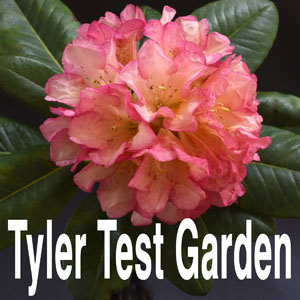
Species Rhododendrons
Genus Rhododendron has its place in the plant kingdom as follows:
- Kingdom: Plantae (Plant Kingdom)
- Sub Kingdom: Tracheobionta (Vascular Plants)
- Super Division: Spermatophyta (Seedbearing Plants)
- Division: Magnoliophyta (Flowering Plants)
- Class: Magnoliopsida (Dicotyledons, having 2 seed leaves & net-veined leaves)
- Sub Class: Dilleniidae (Syncarpous, having fused carpels, and Polypetalous, having separate petals)
- Order: Ericales (wide assortment of plants with showy flowers)
- Family: Ericaceae (Heath Family of mostly acid loving plants)
- Genus: Rhododendron L.
Species rhododendrons are rhododendron varieties that grow naturally in the wild. Plant collectors have been collecting rhododendron species for over a century from all over the world. They may be propagated from seed or cuttings. Since they all include the word Rhododendron in their name, it is frequently abbreviated as R. The genus Rhododendron includes both rhododendrons and azaleas. Both are members of the genus Rhododendron, and have very similar blossoms. The basic difference is that azalea flowers have five pollen-bearing stamens while rhododendrons have 10 or more. There is some variation in a species at different locations in the wild. The most outstanding natural selections are named. For example, R. carolinianum Album is a white form of R. carolinianum.
Rhododendrons are frequently divided into five categories: azaleas, elepidotes, lepidotes, vireyas and the "Other Rhododendron Groups".
- The Azaleas are often considered as distinct from other rhododendrons and in fact formed a separate genus from 1753 to 1796. Azaleas are divided into two groups: Deciduous Azaleas and Evergreen Azaleas, but there is some deciduous azaleas are grouped with evergreen azaleas.
- The Lepidote Rhododendrons have minute scales on the leaves and are generally the small-leaved species.
- Conversely, the Elepidote Rhododendrons don't have leaf scales and are generally the large-leaved species. They usually have leaf hairs and frequently have indumentum, a covering of leaf hairs on the underside of the leaf. Azaleas don't have scale and do have leaf hairs, hence they are among the elepidotes even though they usually have small leaves. Other characteristics separate azaleas from other elepidotes.
- Vireyas are tropical rhododendrons and have scales, hence they are often lumped with the lepidote rhododendrons.
- The "Other Rhododendron Groups" are the ones that don't fit in these major rhododendron groups. These include:
*Note: a subgenus or subsection only contains species. Since most hybrids have parents from one subgenus, they are lumped with that subgenus. Those who are the result of the intergenus crosses with both azaleas and rhododendron parents can be lumped in the nothosubgenus Azaleodendron which is a term reserved exclusively for hybrids.
There are about 750 species in the genus rhododendron. More recently, the genus Rhododendron has been divided as follows:
| Subgenus |
Members |
| Azaleastrum |
45 evergreen azaleas
6 deciduous azaleas |
| Choniastrum |
5 elepidote species |
| Hymenanthes |
199 elepidotes
20 deciduous azaleas |
| Rhododendron |
154 lepidotes
319 vireyas |
| Therorhodion |
2 deciduous elepidote species |
Within each subgenus, rhododendrons will usually readily hybridize.
Return to Top
History of Genus Rhododendron
Rhododendrons belong to the family Ericaceae. There are very few rhododendron fossils. The ericaceous plants (recognizable by their fossilized pollen grains that are arranged in groups of four) appeared first in the Maastrichtian Stage about 68 million years ago. The Maastrichtian is the last stage of the Cretaceous Period and immediately precedes the extinction of dinosaurs. The earliest rhododendron fossils are leaf imprints in rocks of early Tertiary age (about 50 million years old) from Alaska. Other fossils are known from the Tertiary and Pleistocene deposits of North America. These records indicate that rhododendrons have been in existence for at least 50 million years. They could have been in existence before that time, but not before 68 million years ago when the Ericaceae first appeared. This is of interest because it indicates that rhododendrons probably did not originate in the region of mountainous regions of SE Asia or in the high-island archipelago stretching between mainland Asia and Australia - the islands of Java, Sumatra, Borneo, New Guinea, and the Philippines (where they are now most abundant and most diverse) because these regions did not exist 50 million years ago.
E. Irving and R. Hebda of Victoria, Canada, have studied fossils and the genetics of rhododendrons and inferred the possible way they became distributed the way they are today. The essence of their thesis is that, following a period of mild climate when rhododendrons were widely and more-or-less continuously distributed across North America and Eurasia, their range became much reduced as a result of global climatic deterioration. This deterioration began about 25 million years ago, was clearly marked by about 15 million years ago, and became extreme with the onset of the current glacial period about 3 million years ago. Small populations of the subgenera Hymenanthes and Rhododendron (but not azaleas) situated on the edges of their main range were able to enter and retain a foothold in the newly developing region of extreme relief on the southeastern fringe of the Tibet-Himalayan region. There they proliferated, and it was from there that the vireyas spread into the mountains of the high-island archipelago stretching between mainland Asia and Australia. By taking advantage of special newly developing conditions, these small, originally populations have become now the most numerous and diverse. The place of origin of rhododendrons is not known, but it was not the region of extreme relief on the southeastern fringe of the Tibet-Himalayan region where they are nowadays most diverse and abundant.
The azaleas are not in the mountains of SE Asia although they live close by in terrain of about one half or one third the altitude. Presumably, because of their genetic make-up and historical circumstances, they were unable to take advantage of the dynamic environment of that region. In this respect, the paleogeographical evolution of azaleas appears therefore to have been very different from that of other rhododendrons.
Return to Top
Native Rhododendrons
and Azaleas of North America
According to the USDA native stands of species of rhododendrons are found in all US states and provinces of Canada except:
Arizona
Hawaii
Indiana
Iowa
Kansas |
Nebraska
New Mexico
Utah
Wyoming |
There are at least 27 species that are native to North America.
DA=deciduous Azalea,
DE=deciduous elepidote rhododendron,
ER=elepidote rhododendron,
LR=lepidote rhododendron
Return to Top
Native Rhododendrons & Azaleas of North America
R. alabamense, the Alabama Azalea – 4', -5F. It is a deciduous azalea found in Alabama and adjacent states. It has snowy white flowers with a prominent yellow blotch. Blooming in midseason, the flowers have a distinct lemon-spice fragrance and measure .8 to 1.5 inches across. Originally thought to be a white form of R. periclymenoides (R. nudiflorum) , this plant was first described by Dr. C. Mohr in 1883. It grows naturally in north central Alabama, and western to central Georgia and South Carolina. R. alabamense is low to medium in height, and spreads by underground stems or stolons. It propagates with relative ease from softwood cuttings and makes a delightful landscape plant. Natural hybrids of R. alabamense and R. canescens are known to occur. Usually R. alabamense grows in drier woods and R. canescens grows in bottom-lands and near streams.
R. albiflorum – 3', -25F. The Cascade Azalea, is an upright, white-flowering, deciduous azalea that is found in western North America from British Columbia and Alberta to Oregon and Colorado near the timberline. Rhododendron albiflorum was discovered by Mr. Drummond during the early nineteenth century. In 1834, Sir William Jackson Hooker sent seeds to Dr. Graham of Edinburgh, where it flowered in Scotland in 1837. John G. Millais reported having seen thousands of acres of it growing above 4,000 feet elevation in the mountains of Washington State and British Columbia in such dense thickets as to be called "The Miner's Curse." Although it does not do well in cultivation except in Scotland, it is classified in Section Sciadorhodion, which includes R. vaseyi and R. schlippenbachii which do well in cultivation.
R. arborescens – 5', -15F. The Sweet or Smooth Azalea, is a deciduous azalea found from Pennsylvania south to Georgia and Alabama. It is a good late flowering, scented species that can be used in cultivation. The flowers have a strong, cinnamon-like fragrance. It has white to blush pink flowers with red stamens, and a very strong fragrance similar to heliotrope. It blooms in late spring to early summer and individual flowers measure 1.5 to 2 inches across. It has glossy leaves and red fall foliage. Rhododendron arborescens was probably discovered by John or William Bartram and appeared in Bartram's catalogue as Azalea arborea. It may have been sent to England by the Bartrams before the introduction date of 1818 stated by Robert Sweet. Pursh referred to it as the finest ornamental shrub he knew in 1814 after seeing it in the Bartram garden. Ernest Henry Wilson stated this handsome plant was still very seldom seen in cultivation in 1921. This species has a wide distribution in the eastern United States, but can usually be found growing near streams or moist areas. It is sometimes known as the "Smooth Azalea" because the stems are very smooth and do not have hairs similar to the other azaleas. An excellent landscape plant, R. arborescens can perfume a wide area when in bloom. Relatively easy to propagate, there are a number of excellent forms in the trade. Natural hybrids are known to occur with R. cumberlandense and occasionally with R. viscosum.
R. atlanticum – 3', -15F. The Atlantic or Dwarf or Coastal Azalea, is a low deciduous azalea found on coastal plains from Pennsylvania and Delaware south to Georgia. It is a good late flowering, scented species that can be used in cultivation. Flowers have a rose-like fragrance. It is a common understory plant along the southeastern coastal plains of the United States. The white flowers are 1 to 1.5 inches across, but are often blushed with pink on the outside and some have a yellow blotch. Collected by John Clayton in 1743, this plant was appreciated more in England than in its native land. The plant habit is relatively low, 3 to 5 feet tall, but stoloniferous. Spreading by underground stems, R. atlanticum can develop into very large colonies of an acre or more in sandy soils. R. atlanticum is easy to propagate, and makes a nice landscape plant in heavier soils which will restrict the spreading habit. It is a tetraploid, meaning it has twice the number of chromosomes of most rhododendrons and as a result will not hybridize with them. [back to list]
More Native Rhododendrons & Azaleas of North America
R. austrinum, the Florida Azalea – 5', -5F. It is a deciduous azalea found from northwest Florida to Georgia, Alabama and southeast Mississippi. This plant blooms in early spring as the leaves are beginning to expand. The fragrant, sometimes lemony, blossoms come in shades of orange through gold and yellow with a reddish tube, and measure approximately 1 to 1.5 inches across. This species has very long stamens and the tube of the flower is often flushed with red but there is no blotch. Discovered by Dr. A. W. Chapman before 1865, R. austrinum is similar in many respects to R. canescens including the sticky glandular hairs on the flower tube, but differs in the color variations which are orange to yellow rather than pink to white. R. austrinum makes an excellent landscape plant as well as a valuable hybridizing resource, especially in southern gardens where heat tolerance is important. It is a tetraploid, meaning it has twice the number of chromosomes of most rhododendrons and as a result will not hybridize with them. Natural hybrids between R. austrinum and R. canescens do occur but aren't common since R. austrinum is found in upland woods and R. canescens is found in low areas near streams. Although R. austrinum resembles R. canescens, it is more closely related to R. luteum and R. occidentale.
R.
calendulaceum, the Flame Azalea – 6', -10F. It is a tall deciduous azalea found from southwest Pennsylvania south through the Appalachian Mountains to Georgia and Alabama and west to West Virginia and southeastern Ohio. It is surely one of the most spectacular native shrubs of the Appalachian Mountains. The flowers are larger than most of the natives, measuring from 1.5 to 2.5 inches across, and come in a wide range of colors from brilliant shades of yellow to orange or red, with a large prominent yellow to orange blotch on the upper lobe (petal). R. calendulaceum, described as Azalea lutea by Linnaeus in 1753 and changed by him to A. nudiflora in 1762, was discovered in Northern Georgia in 1774 by William Bartram who described the species as Azalea flammea in 'Travels' (1790). There were numerous introductions from America to Europe where the species was highly prized. This species is difficult to propagate by cuttings, but is easily raised from seed. R. calendulaceum is a naturally occurring tetraploid, having twice the number of chromosomes in comparison to the other native species. Because of this fact, it does not hybridize easily with most of the other natives and even if a first generation cross is made, the resulting hybrids are often sterile. R. cumberlandense is often very similar to R. calendulaceum, but is separated by the fact it is a diploid while R. calendulaceum is tetraploid.
R. camtschaticum, formerly called Therorhodion camtschaticum – 1', -25F. It is a deciduous elepidote rhododendron found in northeast Asia to Japan, coastal Alaska, British Columbia and also abundant in West Greenland, . This low growing rhododendron has the unusual trait that the one to three flowers appear at the end of young leafy shoots of the current year, and not from special buds. It does well in cultivation in alpine regions of Northern Germany and Eastern Scotland. It is difficult to grow in warmer climates. R. camtschaticum was first described in 1784 by Pallas. R. camtschaticum was first introduced to Britain in 1799. It was rare in British gardens in 1917 due to problems of cultivation.
R. canadense, the Rhodora Azalea – 2', -25F. It is a low deciduous azalea found from Eastern Quebec to Newfoundland and Nova Scotia, and south the northern parts of Pennsylvania and New Jersey. It has showy lavender flowers. It has a white form that comes true from seed. It does well in moist acidic soils. Rhododendron canadense is a very unusual native azalea species and was originally considered an entirely separate genus, Rhodora . The top three petals of the flower are fused together almost to the end to form a single lobe, whereas the bottom two are completely separate lips. The purplish pink blossoms are approximately 1.5 inches across and have 10 stamens, twice the number of most east coast natives. R. canadense was first described and pictured by Henri Louis Duhamel du Monceau in the 'Botanic Garden' in Paris in March 1756, where it had been brought from Canada and later by Linnaeus in 1762. Samuel Gottlieb Gmelin referred it to the genus Rhododendron in 1791, and that same year the species was introduced to England. R. canadense is a low stoloniferous shrub that is the most northern of the east coast native azaleas, the species is very cold hardy but a difficult plant where summers are hot and dry. Although R. canadense, a tetraploid, is very distinctive, it is most closely related to the diploid, R. vaseyi. [back to list]
More Native Rhododendrons & Azaleas of North America
R. canescens, the Florida Pinxter or Piedmont Azalea – 5', -5F. It has white to pinkish tubular flowers with stamens two to three times longer than the petals. It is often confused with R. periclymenoides. Both are medium deciduous azaleas that are found in the Carolinas but can be separated by the flower tubes, which in R. periclymenoides are fuzzy. R. canescens also has tiny hairs, but they are sticky
and glandular. Another noticeable difference is that when a flower
of R. periclymenoides dies, a ridge on the corolla tube tends
to catch on the end of the pistil so that a flower cluster past
its prime consists of several dangling blossoms. Although
widespread in the eastern half of the U.S., these two wild azaleas
differ in distribution. In South Carolina, for example, R.
periclymenoides is a Piedmont plant, with almost no specimens
reported from the Sandhills or Coastal plain, while R. canescens is predominantly a Low Country plant absent from the Piedmont,
except in counties that border the Savannah River. In general,
if it grows wild north of South Carolina, it's likely R. periclymenoides; south of the Palmetto State and it's probably R. canescens. Both species prefer moist, humus-laden, acidic soil but seem to do equally well in shade or sun. Old specimens can reach heights of 12-15 feet and have multiple stems or trunks up to 5" in diameter. Rhododendron canescens was discovered by Mark Catesby, who published a picture of it in 1731. Michaux collected it in South Carolina between 1784 and 1796. It was probably introduced to England in the mid-eighteenth century. R canescens forms natural hybrids with several species that occur within its geographic range.
R.
catawbiense, the Mountain Rosebay – 5', -25F. It is a medium to tall elepidote rhododendron native from Virginia south to Georgia and west to Alabama, Kentucky and West Virginia. It is quite hardy and has a good plant habit. It has large rose to purple-lilac colored flowers. It was first collected by A. Michaux in 1803 and was introduced to Britain by John Fraser in 1809. Through selection and hybridization this species was parent to a very valuable group of May flowering garden rhododendrons from the white 'Catawbiense Album' to the violet 'Catawbiense Boursault' including 'Everestianum' and 'Fastuosum Floro Plenum'. It is very similar to R. ponticum, which is native to Southern Europe from Portugal and Spain to Turkey and Lebanon.
R. colemanii, the Red Hills azalea – 6', -5F. From the upper Coastal Plain of Alabama and Western Georgia, it was named in 2008. It was initially collected and propagated by S. D. Coleman, Sr. It is one of the tallest, most fragrant and most richly colored of all the native azaleas. Different plants may show flower colors ranging from pure white to deep pink, and even yellow or nearly orange. It's also late-blooming, typically flowering in early May. In the field, the azalea can be distinguished from R. alabamense and other coastal azaleas by its late spring (early to mid May) flowering time, its wide range of flower color (white, pink or yellow), longer flower buds, its often warty seed capsules with glandular hairs, and its taller stature (3-7 m). Its natural distribution extends from southwestern Alabama to the Chattahoochee Valley in Georgia. It is a tetraploid, meaning it has twice the number of chromosomes of most rhododendrons and as a result will not hybridize with them.
R. cumberlandense, the Cumberland Azalea – 4', -15F. It is a low deciduous azalea found in Kentucky, Virginia, Tennessee, North Carolina, Georgia and Alabama. It has long been grown under the name, R. bakeri. It is an excellent, low-growing, late blooming orange to red-flowered azalea suitable for small gardens. The flowers are not large, about 1.5 to 1.75 inches across, and typically range from yellowish-orange to deep red. This species is sometimes difficult to distinguish from the larger flowered R. calendulaceum, but the blossoms generally appear several weeks later after the leaves have fully expanded and the undersides of the leaves are usually waxy white or bluish in color. The species distinction for R. cumberlandense was first described by Lemon and McKay in 1937. This native azalea makes an excellent landscape plant in its own right, but it also hybridizes easily with many of the other species, producing beautiful hybrids in a broad range of colors. R. indicum, or the Satsuki azalea, is one of the oldest evergreen Japanese azaleas, bred since ancient times, and it is the type most commonly used for ornamental hybrids. It is a slow-growing evergreen shrub that eventually becomes 3 to 6 feet tall and is hardy to Zone 5, to -15° F. Its 1 1/2-inch-long oval leaves grow on finely twigged branches. In the species, the flowers are red tinged with purple, about 2 to 3 inches wide, but it has been bred in many other colors. For a while it was called R. bakeri but this was found to be in error on two counts. First, it was very different than R. bakeri, and second, R. bakeri was found to be a natural hybrid of R. flammeum and R. canescens. In the southern Blue Ridge, R. cumberlandense can hybridize with R. arborescens or R. viscosum.[back to list]
More Native Rhododendrons & Azaleas of North America
R. subarcticum, Formerly R. tomentosum ssp. subarcticum and Ledum subarcticum – 1', -20F. It is an upright lepidote rhododendron that is found in the arctic regions of North America, Europe and Asia. It blooms heavily with white trusses. It does well in alpine gardens. A circumboreal subspecies with an extensive range throughout the boreal portions of the northern hemisphere, it occurs in a wide variety of habitats.
R. eastmanii, the May white azalea – 3', -15F. It is a deciduous azalea found in South Carolina in 13 counties of the piedmont and coastal plain to date, officially named, described and proposed as a new species in Novon in September of 1999. It has snowy white flowers with a prominent yellow blotch. Blooming in mid May, the flowers have a distinct, strong, fresh fragrance and measure .8 to 1.5 inches across. Originally thought to be R. alabamense, this plant was first described, noticed and thought to be different from known S.C. species by Charles Eastman in the early 1980s, one hundred years after Dr. C. Mohr discovered R. alabamense. R. eastmanii is low to medium in height, and has a clump habit but does not spread by underground stems. It propagates with relative ease from woody cuttings and makes a delightful landscape plant.
R. flammeum, the Oconee Azalea – 3', -5F. Formerly R. speciosum, it is a deciduous azalea found in the lower Piedmont from central Georgia to South Carolina. It is seldom cultivated in cooler climates but does well in the southeast. Its blossoms are approximately 1.2 to 1.8 inches across and come is shades of yellow, yellow-orange or red. This species can be distinguished from the earlier blooming R. austrinum in that the flowers usually have a large yellow blotch on the top lobe (petal), they are not fragrant, nor do they have sticky glandular hairs on the corolla tube. R. speciosum was collected by Michaux on April 26 and 27, 1787 near Two Sisters Ferry on the Savannah River described in his 'Flora' as A. calendulacea var. flammea. Several other early collections were also made of this species. Sweet incorrectly assigned the name R. speciosum in 1830. Plants of this species were described by Aiton at Kew Gardens in 1789 and were probably sent there by William Bartram prior to that date. The correct name of this species has been R. flammeum since Sargent (1917) raised Michaux's A. calendulacea var. flammea to specific rank. This species is a heat tolerant shrub and holds much breeding potential where hot summer stress is a problem. It differs from R. calendulaceum by being diploid while R. calendulaceum is tetraploid.
R. groenlandicum, Bog Labrador Tea – 2', -25F. It is an upright lepidote rhododendron that is found from the northern USA, through Canada and into Greenland. It blooms heavily with white trusses. It forms small erect to rounded evergreen shrubs. The stems and lower surface of the leaves are covered with a thick rufous indumentum. The leaves are dark smooth green above with a fairly distinct reticulation. This was formerly known as Ledum groenlandicum before that genus was merged into the genus Rhododendron. In northern North America this species is often abundant in bogs, wet marshes, moist forests etc. from sea-level to around 6,000 ft. It was introduced in 1763. [back to list]
More Native Rhododendrons & Azaleas of North America
R. lapponicum, the Lapland Rosebay – 2', -25F. It is a very low lepidote rhododendron found in Russia, Scandinavia, Canada and Alaska. It is also found in mountains from Maine to Wisconsin. It has clusters of pink to lavender flowers. It is found on mountain tops and in sub arctic areas. It was first described by Wahlenberg in 1812.
R. macrophyllum, the Pacific Rhododendron – 5', -5F. It is a vigorous, upright, elepidote rhododendron that is found from Northern California to British Columbia. Discovered in 1792 by Archibald Menzies, it has pink to rose colored flowers. It is seldom found in cultivation. It is closely related to R. maximum.
R.
maximum, the Great Laurel – 5', -25F. It is a large elepidote rhododendron found from Nova Scotia to Georgia and west to Alabama and Ohio in dense forests. Since deer were introduced in Nova Scotia around 1887, R. maximum has apparently disappeared from Nova Scotia according to John Weagle of Halifax. This tall straggly plant has pinkish-white flowers. It long slightly narrow leaves have a thin indumentum on the underside. It is a large hardy plant with small trusses. R. maximum was introduced to England in 1736 by Peter Collinson from eastern North America, but as such was never very popular there. The true species was reported to be at Leonardslee by J. G. Millais in 1917. This species was one of the chief progenitors of a hardy group of English garden hybrids.
R. minus, Carolina rhododendron – 4', -15F. It is a low growing rhododendron found from Florida and Alabama up to Tennessee and North Carolina in mountains and plains. R. minus, first described as such by Michaux in 1792, was long known as R. punctatum. John Fraser introduced the species to England in 1786 where it was still rare in 1917. R. minus was crossed with R. ferrugineum to give the curious shrub known as 'Daphnoides'. R. minus, is actually a composite of three distinct plants:
- R. minus var. minus grows on the exposed cliffs of mountains, in the piedmont, and along streams of North and South Carolina, Georgia and Alabama. It is typically a straggly tall shrub but good horticultural selections for habit, late bloom time and color have been made.
- The form growing in the Chattahoochee region of Georgia and Alabama is distinct horticulturally and more attractive in flower than the type from North Carolina. It is shorter and earlier blooming by two weeks than those from North Carolina. Flowers of the Chattahoochee R. minus often have yellow-orange flares.
- The Carolinia form is later blooming by two weeks. This form is very heat tolerant and has been used as a parent for very hardy hybrids such as P.J.M. It historically was called R. carolinianum. It is 3 to 6 feet high with a naturally rounded shape and dark green leaves 3 inches long. In mid-spring it is covered with 3-inch clusters of rose-pink flowers. The Carolina rhododendron is hardy to Zone 5, -15° F. This is one of the most satisfactory species for northern gardens, becoming a thickly branched, rounded shrub that usually grows 3 to 4 feet tall in 10 years. In mid-spring it is smothered with 3-inch clusters of small rosy pink flowers. The 1 1/2- to 3-inch dark green leaves are brown underneath. There is also a variety with pure white flowers and lighter green leaves. It was first collected by A. Michaux in 1792.The Carolinianum Group has openly funnel-shaped flowers with green flares, a shorter floral tube, and ovate leaves. It is a bushy and compact shrub, and not as leggy as it's siblings.
More Native Rhododendrons & Azaleas of North America
R. minus, besides minus var. minus, the other variety is:
- R. minus var. chapmanii is an endangered variety often given species status as R. chapmanii. There are only 3 known populations in the hot coastal plains of northern Florida. Geographically isolated from R. minus var. minus it grows on sands that have abundant organic matter and are well drained at the surface but with permanently saturated acid water just below the surface. It prefers light shade and can be found between the drier pine-turkey oak vegetation and the moister titi (Cliftonia) bogs. R. minus var. chapmanii grows to 6 feet (2 m) tall, and is stoloniferous, resprouting easily when cut back. The leaves are smaller than var. minus, with a rounded leaf tip and more oval shape. The leaves are aromatic when crushed and the upper surface is distinctly rugose. There are reports of some variability in color forms in the wild. Breeding with R. minus var. chapmanii is thought to increase the heat tolerance of its offspring. [back to list]
R. neoglandulosum, Trapper's Tea or Glandular Labrador Tea – 1', -10F. It is an upright lepidote rhododendron that is found in more sunny locations from California through various mountainous habitats north to British Columbia, west to Montana, and south to Wyoming. It is native to well-drained but not too dry soil. Quite distinct in appearance, it blooms heavily with small round balls of white trusses. It was first introduced in 1894. It was long grown as Ledum glandulosum. Small and rounded to upright evergreen shrubs with ovate-elliptic leaves. These are smooth and bright green on the lower surface (unlike most species formerly included in the genus Ledum). It was long grown as Ledum glandulosum.
R. occidentale, the Pacific or Western Azalea – 5', -5F. It is a tall deciduous azalea found in Oregon and California. The flower color is usually white or pale pink with a strong yellow flare, but may be red, yellow or orange-pink and occasionally the flare is maroon. The foliage turns red and copper shades in the fall. It is among the showiest of all species with bright colors on impressive flowers. However it is difficult to propagate and grow. It is considered nearly impossible to grow on the East Coast of the US. Rhododendron occidentale grows naturally west of the Rocky Mountains in the United States. William Lobb, a collector for Veitch and Sons of Exeter, is credited with having introduced R. occidentale to England in 1850. R. austrinum and R. luteum are most closely related to R. occidentale but don't have occidentale's white corolla.
R. periclymenoides, formerly R. nudiflorum, the Pinxterbloom Azalea – 5', -15F. It is a medium deciduous azalea found widespread from Vermont and Massachusetts south to South Carolina and north Georgia and Alabama and west to Tennessee and Ohio. It has showy flowers that are either white, pale pink or deep pink. Pinxter-flower, with lightly fragrant inch-wide blooms, is perhaps the most common and most familiar wild azalea in the eastern U.S. The name "pinxter" comes not from its coloration but from the Dutch words Pinxter blomachee, which relate to the fact that this is supposedly the azalea that blossoms on Pentecost, 50 days past Easter. We suspect this name was given by folks in northern parts of the plant's range, since in the Carolinas it is more likely to be in bloom for Easter Sunday itself. R. periclymenoides, was probably discovered by John Banister. Plunkenet described it as "Cistus virginiana pericyclemeni flore ampliori et minus odorato". It was introduced to England between 1725 and 1730 by Peter Collinson who received it from John Bartram in America. R. periclymenoides is often mistaken for R. canescens. . In general,
if it grows wild north of South Carolina, it's likely R. periclymenoides; south of the Palmetto State and it's probably R. canescens. [back to list]
More Native Rhododendrons & Azaleas of North America
R. prinophyllum, formerly R. roseum - 5', -25F. It is a medium deciduous azalea found from southwestern Quebec, through New England, to Appalachian Mountains in Oklahoma and Arkansas at the higher elevations. The flowers are typically rose pink measuring 1.2 to 1.8 inches across and are very fragrant. Assumed to be a form of R. periclymenoides (R. nudiflorum) since its first mention in 1787, it was first described as a distinct species in 1914 by Small but had been under cultivation as A. rosea in Europe before 1812. R. prinophyllum can be distinguished from R. periclymenoides by a number of characteristics including the fact that it is usually deeper pink in color and with a strong cinnamon to clove fragrance. R. prinophyllum is a good landscape plant for northeastern gardens, but may be more difficult in the south because of summer heat.
R. prunifolium, the Plumleaf Azalea – 4', -10F. It is a medium deciduous azalea found on the Georgia-Alabama border. The color ranges from orange-red to red, and occasionally orange or yellow. The petals have a deep red blotch. This species blooms very late, usually in late June or in July. Plants are usually 5 to 8 feet tall, although some mature plants may attain a height of 20 feet. First collected by R.M. Harper in 1913, R. prunifolium prefers more shade than most deciduous azaleas to prolong the flowers during hot summer months. It is the signature plant of Callaway Gardens in Pine Mountain, Georgia. It is closely related to R. flammeum, R. cumberlandense, and R. calendulaceum, but, fortunately, its native range is unique.
R. vaseyi, the Pink Shell Azalea – 4', -15F. It is a medium to tall deciduous azalea found in North and South Carolina. It grows best in the moist soil bordering ponds in Zones 5-8, hardy to -10° F, where they grow 6 to 8 feet tall and bear 1 1/2-inch pink flowers in late spring to early summer. It also has a white variation. It has showy fall foliage when the willow-like leaves turn yellow and red. Discovered by George Vasey in 1878, this native azalea has a relatively restricted natural habitat in four mountainous counties of North Carolina. Growing at elevations of 3000 to 5500 feet, the rare Pinkshell azalea can be seen in bloom along the Blue Ridge Parkway in early spring. It is quite adaptable and makes a good landscape plant. It is a diploid, but is considered to the most closely related to the more northerly tetraploid, R. canadense.
R. viscosum, Swamp Honeysuckle or Swamp Azalea – 6', -20F. It , is a medium deciduous azalea found in low areas along stream banks from Maine to Georgia and west to Texas. R. viscosum now includes two closely related forms that were previously considered separate species, R. serrulatum and R. oblongifolium. The fragrant flowers with a clover-like fragrance are generally white to pale pink, and bloom after the leaves have fully expanded. Flowers vary in size from 0.75 to 1.5 inches across depending upon the form, but have a long narrow tube covered with sticky glandular hairs. It grows up to 9 feet tall and is hardy to -20° F. The leaves turn orange or bronze red in the fall. The species has a wide distribution from Maine to Florida, and westward to Texas. R. viscosum was the first North American azalea grown in England. It can be distinguished from the other late blooming white, R. arborescens in that the stamens are greenish white rather than red, and the stems are not smooth but contain hairs. R. viscosum is a variable species closely related to R. arborescens and R. atlanticum. These species are sometimes not easily distinguished from each other and have been frequently confused. Bishop Henry Compton raised the plant in 1680 from seed collected by John Bannister, an English missionary in eastern North America. John Banister sent a drawing of R. viscosum to Dr. Henry Compton, Bishop of London. Leonard Plundent published it in 'Phytographia' in 1692 after Banister's untimely death. The species was an important parent in early hybridizing efforts with deciduous azaleas. In1734, John Bartram, an American farmer-horticulturist, sent R. viscosum to Peter Collinson in England. In the southern Blue Ridge, R. viscosum can hybridize with R. cumberlandense and occasionally with R. arborescens. [back to list]
How
To Grow Rhododendron Species
Rhododendrons grow best in partial shade, since full sunlight tends to bleach the flowers. They need an acid soil with a pH of 5.0 to 6.0, well mulched with organic material. Mix garden loam with equal parts of coarse sand and ground bark or oak leaves before planting. Soil around the rhododendrons' shallow roots must be kept cool and moist but well drained. All except leather-leaf rhododendrons transplant well in the spring, or in the fall if mild winter weather does not damage the shallow-rooted plants. Do not fertilize at the time of planting, as this might injure the roots, but water deeply. Supplemental feeding later is not normally needed, but if a plant appears pale or droopy, apply cottonseed meal or a fertilizer for acid-loving plants around its base in early spring. A year-round mulch of rotted oak leaves will also provide natural nutrients and will help keep the soil cool and moist.
Prune rhododendrons after the flowers have faded to induce new growth. Most evergreen rhododendrons may be propagated from stem cuttings of new growth taken in late summer and rooted in a mixture of perlite or vermiculite and peat moss. Deciduous rhododendrons are propagated by seed, grafting or cuttings. For deciduous azaleas, cuttings may need bottom warmth of 75° and artificial light to promote root growth.
Do not cultivate around the shallow roots of rhododendrons and azaleas, but pinch off their faded flowers to improve bloom the following year. Also, prune out dead, diseased or damaged branches, and cut old branches back to the soil level to encourage new growth.
[Return to Top]
Rhododendrons belong to the Ericaceae or heath family. Other
members of the Ericaceae include the Erica (heaths), and Calluna
(heathers), Kalmia (mountain laurel), Pieris (lily-of-the-valley shrub), Vaccinium (cranberry), Leucothoe and Andromeda (bog rosemary). Almost
all members of the heath family make good garden plants.
When Linnaeus created the botanical grouping called genus Rhododendron in 1753, he created a separate genus for Azaleas containing 6 species. In 1796 Salisbury pointed out that Azalea and Rhododendron could not be maintained as distinct genera. In 1834, George Don subdivided the genus Rhododendron into 8 sections that were recognized until 2004. Azaleas comprised two of these sections, Subgenus Pentanthera typified by Rhododendron nudiflorum and Subgenus Tsutsusi typified by Rhododendron Tsutsusi.
The extensive collections of rhododendron in the early
1900's from southern Asia made by Forrest, Rock, Kingdom-Ward,
and others stimulated taxonomic work at Edinburgh Botanic Garden
and Herbarium under the direction of Bayley Balfour. The horticulturally
based classification consists of about 45 series. The artificial
classification was intended as a temporary measure, but it became
firmly entrenched following the publication of The Species
of Rhododendron in 1930 by the Royal Horticultural Society.
This system was designed to cope with the vast quantities of new
plant material received from the Orient, North America, etc. Balfour
intended to revise the temporary system but died before it could
be accomplished.
The Series system does not attempt to classify species under
their subgenera and section as proposed in the International Rules
of Botanical Nomenclature. Further, it is based largely on cultivated
plants rather than rhododendron found in the wild. [Return to Top]
The first four of these subgenera contain all species of the entire genus except for five. Of the last four Candidastrum, Mumeazalea and Therorhodion each include only one species (R. albiflorum, R. semibarbatum and R. camtshaticum respectively) while Azaleastrum includes two species (R. ovatum and R. stamineum).
Subgenera Rhododendron and Hymenanthes include the plants that gardeners recognize as the "true" rhododendrons. Some of these, the lepidote rhododendrons, have small scales on their leaves and make up the subgenus Rhododendron. Elepidote rhododendrons, those without leaf scales, form the subgenus Hymenanthes.
Subgenus Pentanthera covered the deciduous azaleas and Tsutsutsi covered the evergreen azaleas.
So the 8 subgenera are:
- Rhododendron (lepidote rhododendrons and vireyas)
- Hymenanthes (elepidote rhododendrons)
- Pentanthera (elepidote deciduous azaleas)
- Tsutsutsi (elepidote evergreen azaleas)
- Azaleastrum (R. ovatum and R. stamineum)
- Candidastrum (R. albiflorum)
- Mumeazalea (R. semibarbatum)
- Therorhodion (R. camtshaticum)
A list of all species and their classification is provided in the Genus Rhododendron Taxonomic Tree. [Return to Top]
The Five Subgenera proposed in 2004
Based upon genetic and chemical data, in 2004, Loretta Goetsch, Andrew Eckert and Benjamin Hall of the University of Washington proposed and in 2005 published a recommendation that the genus Rhododendron be revised and subdivided into five subgenera:
- Hymenanthes (elepidote rhododendrons & deciduous azaleas)
- Azaleastrum (evergreen & deciduous azaleas)
- Choniastrum (R. championae, R. hancockii, R. latoucheae, R. moulmainense, R. stamineum)
- Therorhodion (R. camtschaticum)
- Rhododendron (lepidote rhododendrons & vireyas)
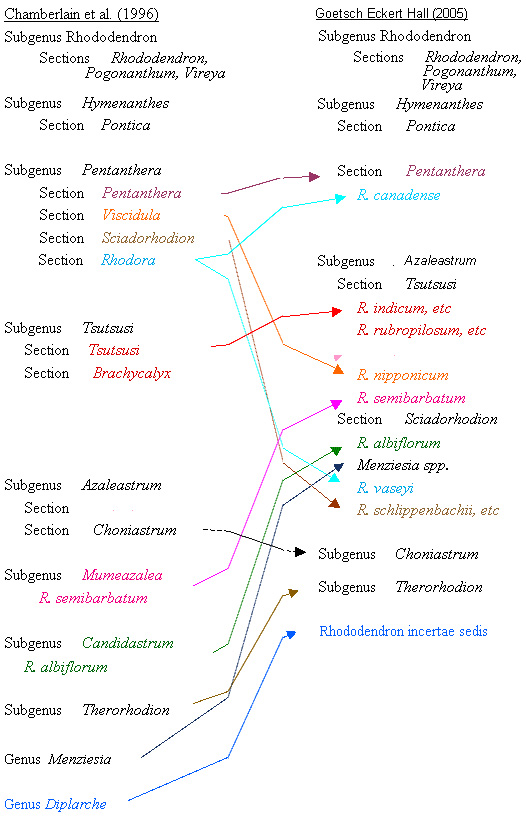
Some of the subgenera are divided into sections that are further divided into subsections. There are also groupings known as alliances and aggregates composed of very closely related species. [Return to Top]
For taxa outside of subgenus Rhododendron, this system eliminates three subgenera and two sections that are present in the 1996 taxonomic system of Chamberlain et al.
Section Pentanthera is included within subgenus Hymenanthes.
Sections Sciadorhodion and Viscidula and R. vaseyi (section Rhodora) from the discontinued subgenus Pentanthera are combined with sections Azaleastrum, Tsutsusi and Brachycalyx to form an expanded and revised subgenus Azaleastrum. Sister groups in this subgenus are the sections Tsutsusi (largely evergreen) and Sciadorhodion (entirely deciduous)
Since Choniastrum lacks lepidote scales on the leaves, Goetsch et al. propose that Choniastrum be considered a separate subgenus. [Return to Top]
A list of all species and their proposed classification is provided in the New Genus Rhododendron Taxonomic Tree. This chart assumes subsections and alliances are carried over from the old Taxonomic Tree. This is probably not a safe assumption but is a pragmatic one.
If you understand the basic ideas of genus, subgenus, section and species you will have a better understanding of rhododendron naming conventions. A rhododendron species can be uniquely identified with the genus and species. Hence Rhododendron albiflorum defines a unique species. There may be another genus that uses the name albiflorum since it is Latin for "white flowering". Return to Top
Genus Rhododendron Taxonomic System of Chamberlain et al. (1996)
Azaleastrum, Azaleastrum, hongkongense, leptothrium, ovatum, vialii, Choniastrum, championae, hancockii, latoucheae, moulmainense, stamineum, Candidastrum, albiflorum, Hymenanthes, Ponticum, subArborea, arboreum, lanigerum, niveum, subArgyrophylla, adenopodum, argyrophyllum, argyrophyllum, hypoglaucum, omeinse, nankingense, coryanum, denudatum, floribundum, formosanum, haofui, hunnewellianum, insigne, longipes, chienianum, longipes, pingianum, ririei, simiarum, thayerianum, subAuriculata, auriculatum, subBarbata
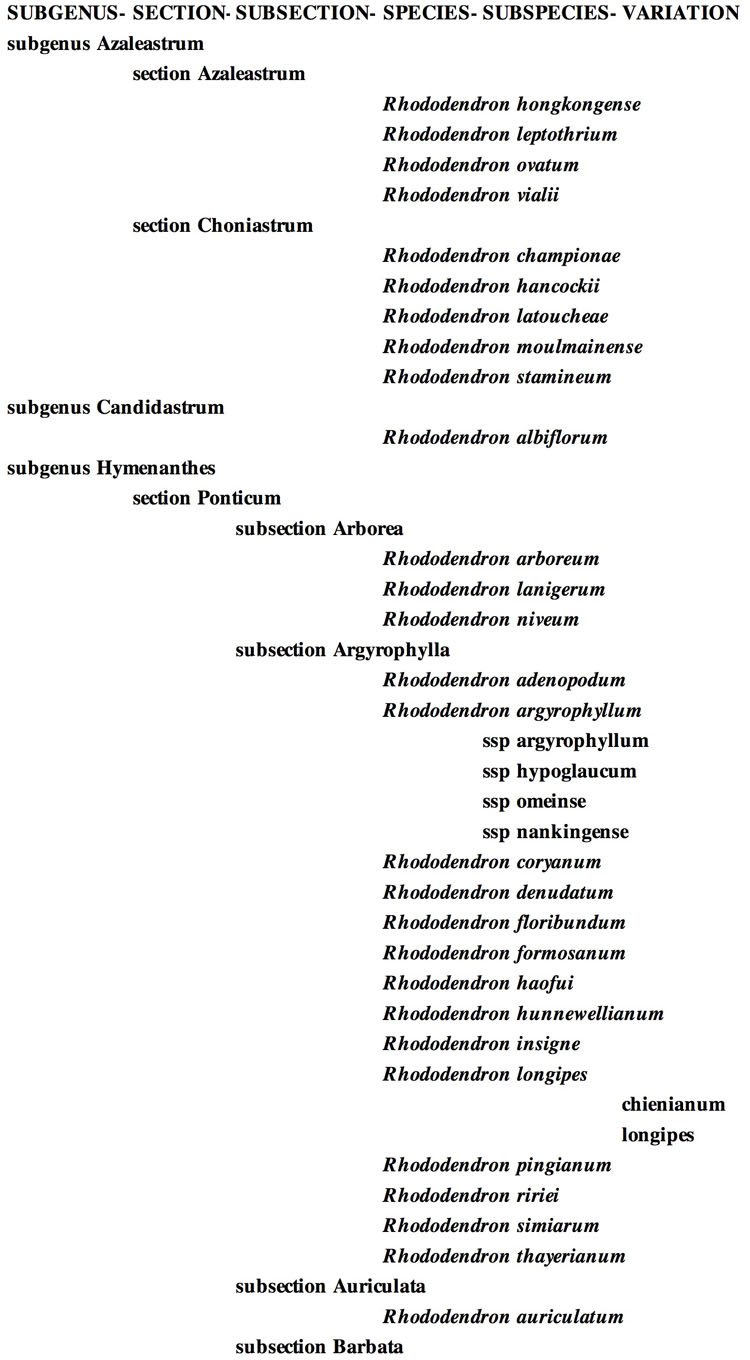 argipeplum, barbatum, erosum, exasperatum, succothii, subCampanulata, campanulatum, campanulatum, aeruginosum, wallichii, subCampylocarpa, callimorphum, callimorphum, myiagrum, campylocarpum, campylocarpum, caloxanthum, souliei, wardii, wardii, puralbum, subFalconera, arizelum, basilicum, coriaceum, falconeri, falconeri, eximium, galactinum, hodgsonii, preptum, rex, rex, fictolacteum, gratum, rothschildii, semnoides, sinofalconeri, subFortunea, asterochnoum, calophytum, calophytum, openshawianum, davidii, decorum
argipeplum, barbatum, erosum, exasperatum, succothii, subCampanulata, campanulatum, campanulatum, aeruginosum, wallichii, subCampylocarpa, callimorphum, callimorphum, myiagrum, campylocarpum, campylocarpum, caloxanthum, souliei, wardii, wardii, puralbum, subFalconera, arizelum, basilicum, coriaceum, falconeri, falconeri, eximium, galactinum, hodgsonii, preptum, rex, rex, fictolacteum, gratum, rothschildii, semnoides, sinofalconeri, subFortunea, asterochnoum, calophytum, calophytum, openshawianum, davidii, decorum
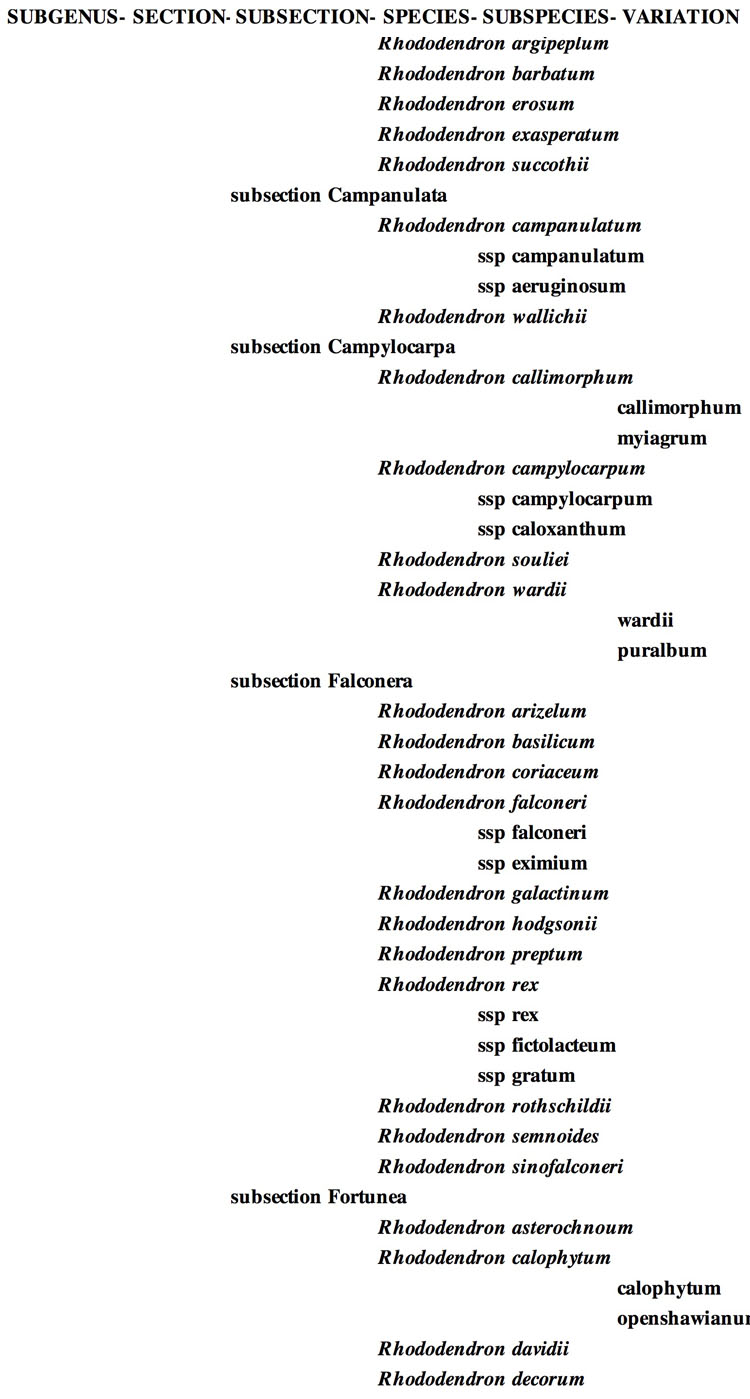 decorum, diaprepes, fortunei, fortunei, discolor, glanduliferum, griffithianum, hemsleyanum, huianum, orbiculare, orbiculare, cardiobasis, oreodoxa, oreodoxa, fargesii, shensiense, platypodum, praeteritum, praevernum, serotinum, sutchuenense, vernicosum, subFulgensia, fulgens, subFulva, fulvum, fulvum, fulvoides, uvariifolium, uvariifolium, griseum, subGlischra, adenosum, crinigerum, cringerum, euadenium, glischroides, glischrum, glischrum, rude, habrotrichum, recurvoides, spilotum, vesiculiferum, subGrandia
decorum, diaprepes, fortunei, fortunei, discolor, glanduliferum, griffithianum, hemsleyanum, huianum, orbiculare, orbiculare, cardiobasis, oreodoxa, oreodoxa, fargesii, shensiense, platypodum, praeteritum, praevernum, serotinum, sutchuenense, vernicosum, subFulgensia, fulgens, subFulva, fulvum, fulvum, fulvoides, uvariifolium, uvariifolium, griseum, subGlischra, adenosum, crinigerum, cringerum, euadenium, glischroides, glischrum, glischrum, rude, habrotrichum, recurvoides, spilotum, vesiculiferum, subGrandia
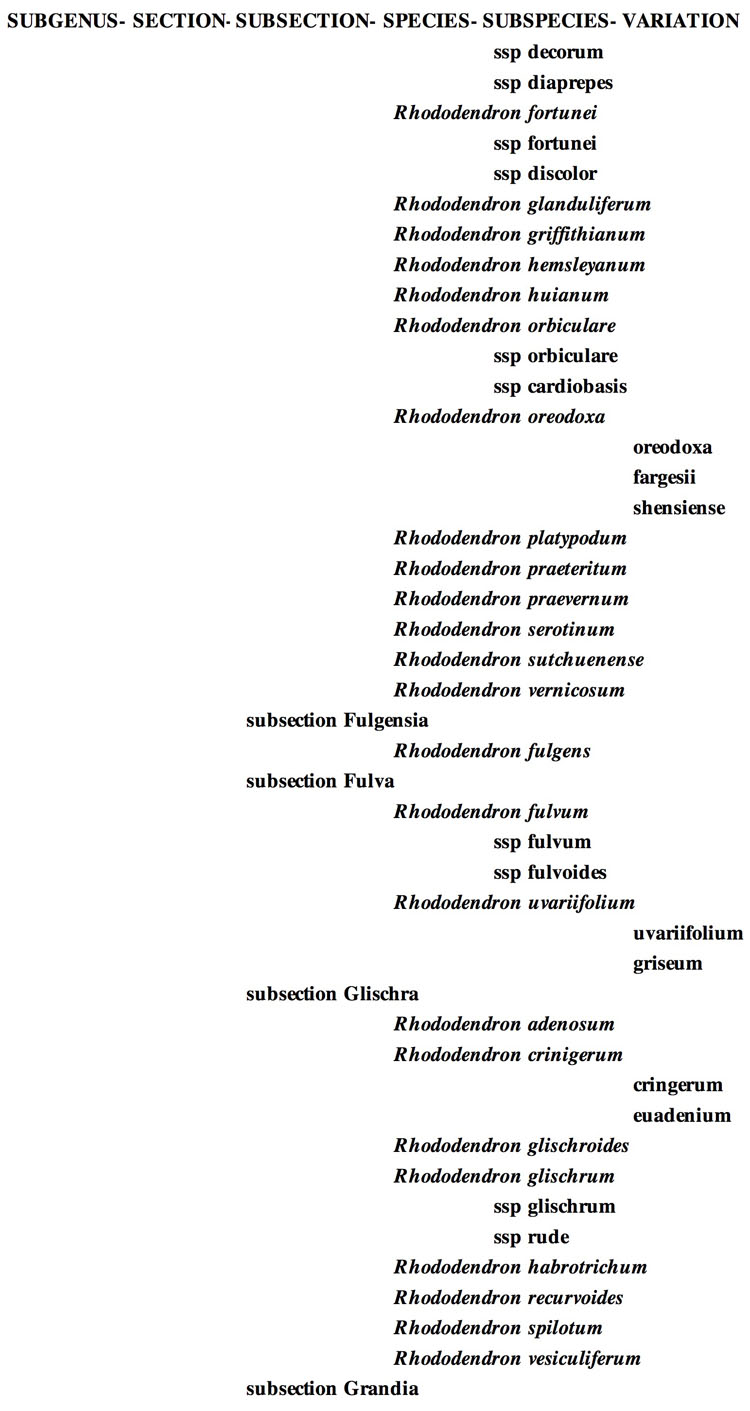 balangense, grande, kesangiae, kesangiae, album, macabeanum, magnificum, montroseanum, praestans, protistum, pudorosum, sidereum, sinogrande, watsonii, subGriersoniana, griersonianum, subIrrorata, aberconwayi, annae, annae, laxiflorum, anthosphaerum, araiophyllum, gongshanense, irroratum, irroratum, pogonostylum, kendrickii, lukiangense, ramsdenianum, tanastylum, tanastylum, pennivenium, wrayi, subLanata, flinckii, lanatoides, lanatum, luciferum, tsariense, subMaculifera, anwheiense, longesquamatum, maculiferum, morii
balangense, grande, kesangiae, kesangiae, album, macabeanum, magnificum, montroseanum, praestans, protistum, pudorosum, sidereum, sinogrande, watsonii, subGriersoniana, griersonianum, subIrrorata, aberconwayi, annae, annae, laxiflorum, anthosphaerum, araiophyllum, gongshanense, irroratum, irroratum, pogonostylum, kendrickii, lukiangense, ramsdenianum, tanastylum, tanastylum, pennivenium, wrayi, subLanata, flinckii, lanatoides, lanatum, luciferum, tsariense, subMaculifera, anwheiense, longesquamatum, maculiferum, morii
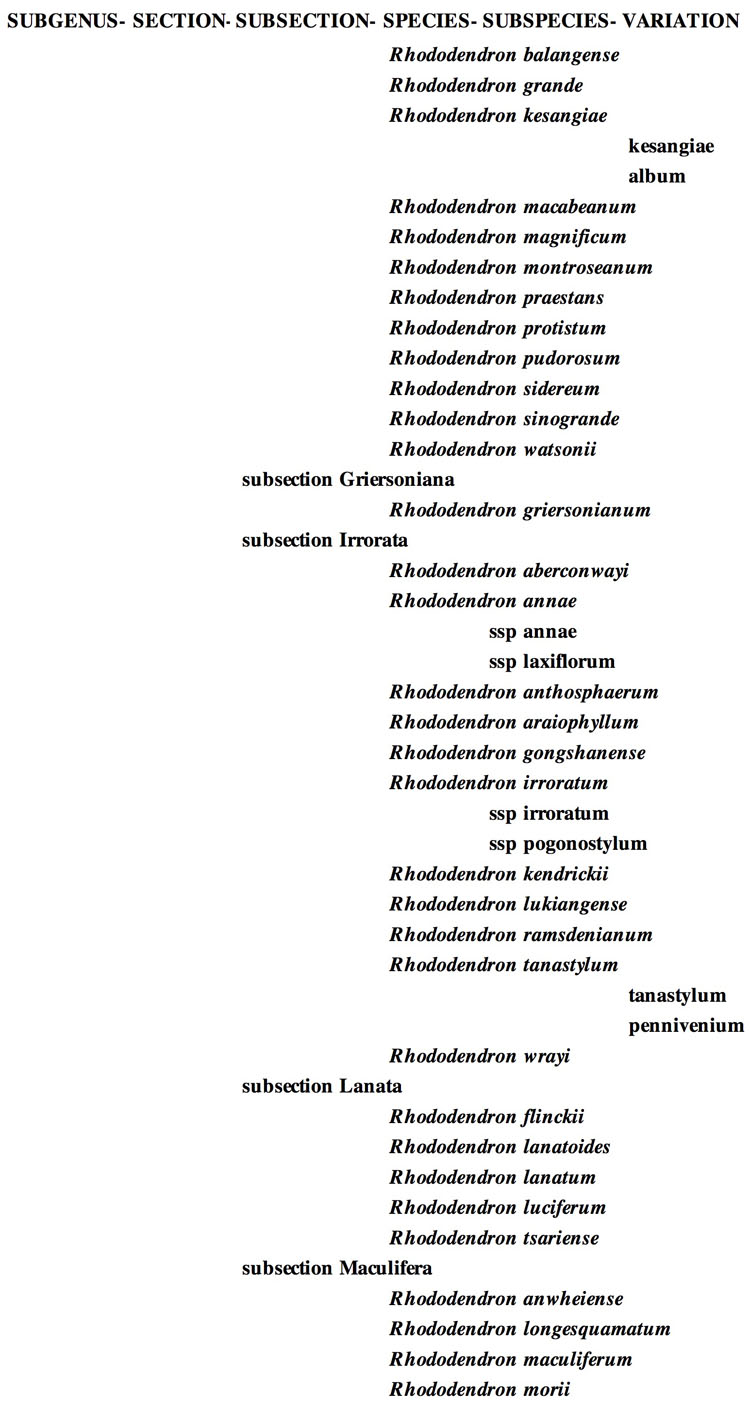 ochraceum, pachysanthum, pachytrichum, pseudochrysanthum, sikangense, strigillosum, subNeriiflora, Haematodes alliance, beanianum, catacosmum, coelicum, haematodes, haematodes, chaetomallum, piercei, pocophorum, pocophorum, hemidartum, mallotum, Sanguineum alliance, aperantum, citriniflorum, citriniflorum, horaeum, dichroanthum, dichroanthum, apodectum, scyphocalyx, septentrionale, eudoxum, eudoxum, brunneifolium, mesopolium, microgynum, parmulatum, sanguineum, sanguineum, sanguineum, himertum, cloiophorum, didymoides, didymum, temenium, temenium, gilvum
ochraceum, pachysanthum, pachytrichum, pseudochrysanthum, sikangense, strigillosum, subNeriiflora, Haematodes alliance, beanianum, catacosmum, coelicum, haematodes, haematodes, chaetomallum, piercei, pocophorum, pocophorum, hemidartum, mallotum, Sanguineum alliance, aperantum, citriniflorum, citriniflorum, horaeum, dichroanthum, dichroanthum, apodectum, scyphocalyx, septentrionale, eudoxum, eudoxum, brunneifolium, mesopolium, microgynum, parmulatum, sanguineum, sanguineum, sanguineum, himertum, cloiophorum, didymoides, didymum, temenium, temenium, gilvum
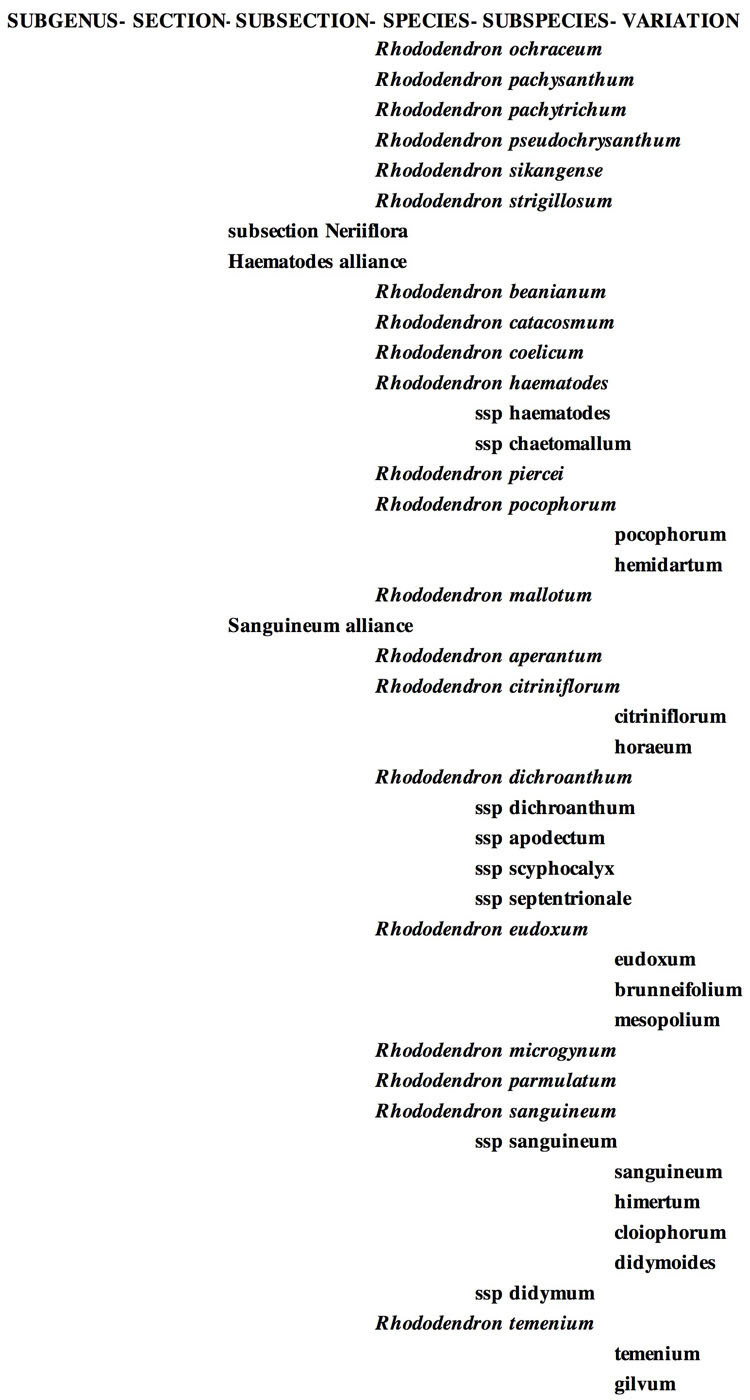 dealbatum, Forrestii alliance, chamaethomsonii, chamaethomsonii, chamaedoron, chamaethauma, forrestii, forestii, papillatum, Neriiflorum alliance, albertsenianum, floccigerum, miniatum, neriiflorum, neriiflorum, agetum, phaedropum, sperabile, sperabile, weihsiense, sperabiloides, subParishia, elliotti, facetum, kyawii, subPontica, aureum, aureum, hypopytis, brachycarpum, brachycarpum, fauriei, catawbiense, caucasicum, degronianum, degronianum, heptamerum, heptamerum, hondoense, kyomaruense, yakushimanum, hyperythrum, macrophyllum, makinoi, maximum
dealbatum, Forrestii alliance, chamaethomsonii, chamaethomsonii, chamaedoron, chamaethauma, forrestii, forestii, papillatum, Neriiflorum alliance, albertsenianum, floccigerum, miniatum, neriiflorum, neriiflorum, agetum, phaedropum, sperabile, sperabile, weihsiense, sperabiloides, subParishia, elliotti, facetum, kyawii, subPontica, aureum, aureum, hypopytis, brachycarpum, brachycarpum, fauriei, catawbiense, caucasicum, degronianum, degronianum, heptamerum, heptamerum, hondoense, kyomaruense, yakushimanum, hyperythrum, macrophyllum, makinoi, maximum
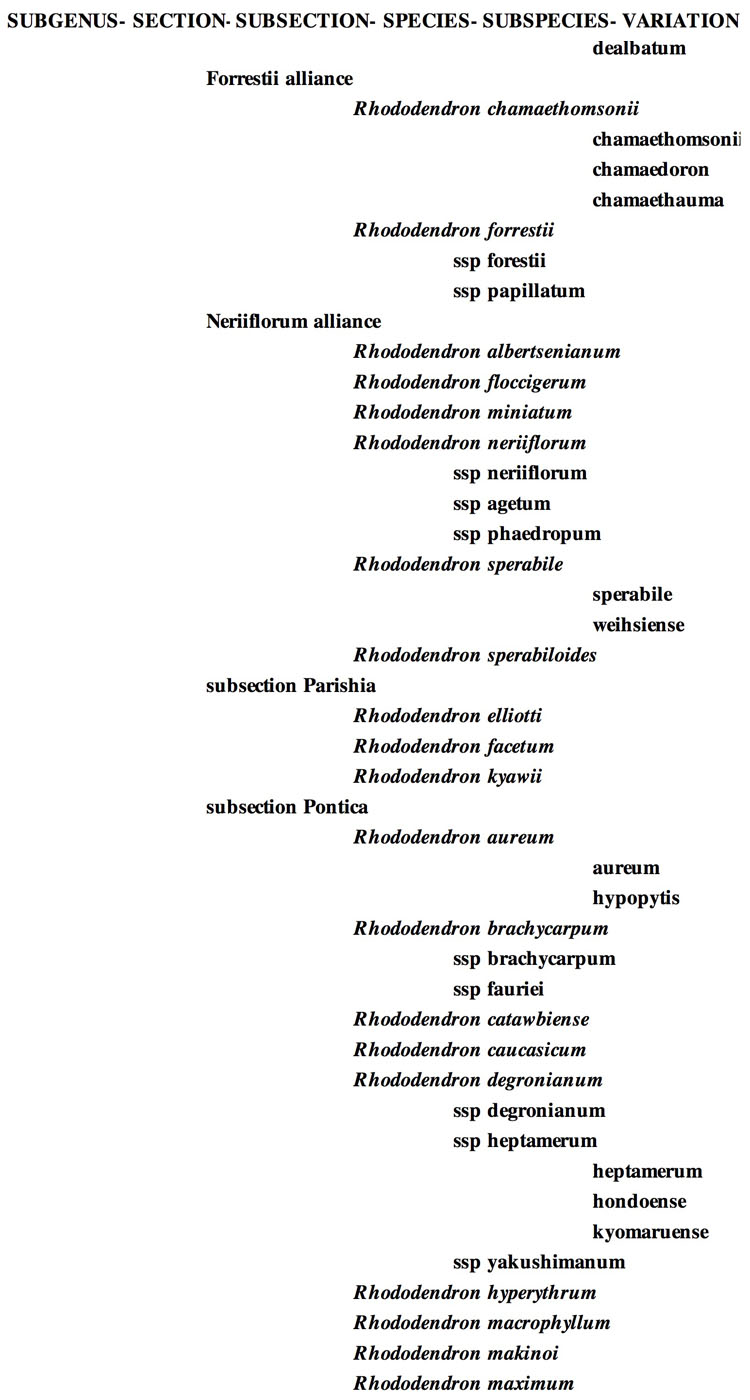 ponticum, smirnowii, ungernii, subSelensia, bainbridgeanum, esetulosum, hirtipes, martinanum, selense, subTaliensia, adenogynum, aganniphum, aganniphum, flavorufum, alutaceum, alutaceum, russotinctum, iodes, balfourianum, bathyphyllum, bhutanense, bureavii, bureaviodes, clementinae, coeloneuron, elegantulum, faberi, mimetes, mimetes, simulans, nigroglandulsom, phaeochrysum, phaeochrysum, agglutinatum, levistratum, prattii, principis, pronum, proteoides, przewalskii, przewalskii, dabanshanense, purdomii, roxieanum, roxieanum
ponticum, smirnowii, ungernii, subSelensia, bainbridgeanum, esetulosum, hirtipes, martinanum, selense, subTaliensia, adenogynum, aganniphum, aganniphum, flavorufum, alutaceum, alutaceum, russotinctum, iodes, balfourianum, bathyphyllum, bhutanense, bureavii, bureaviodes, clementinae, coeloneuron, elegantulum, faberi, mimetes, mimetes, simulans, nigroglandulsom, phaeochrysum, phaeochrysum, agglutinatum, levistratum, prattii, principis, pronum, proteoides, przewalskii, przewalskii, dabanshanense, purdomii, roxieanum, roxieanum
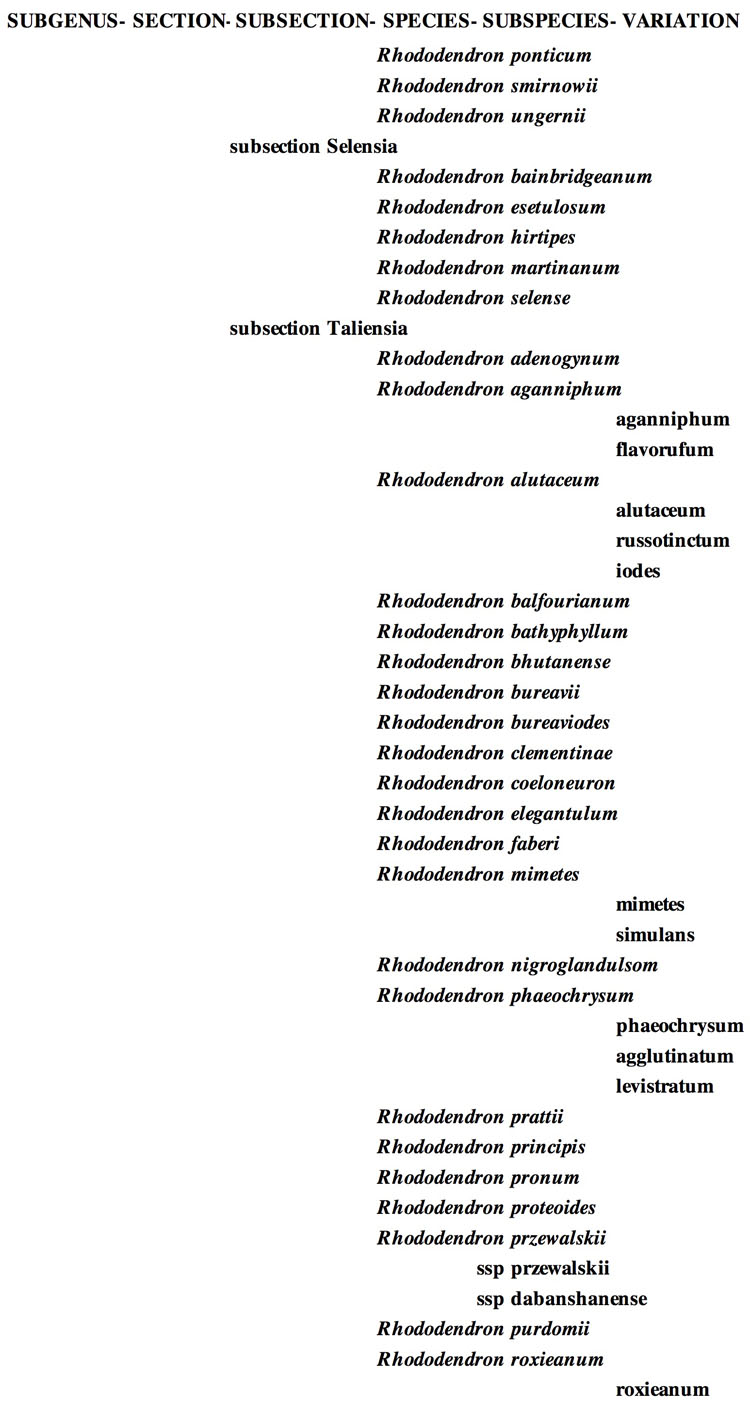 cucullatum, oreonastes, rufum, sphaeroblatum, taliense, traillianum, traillianum, dictyotum, wasonii, wenchuanense, wiltonii, Lacteum alliance, beesianum, dignabile, lacteum, wightii, subThomsonia, cerasinum, cyanocarpum, eclecteum, faucium, hylaeum, hookeri, meddianum, sherriffii, stewartianum, subansiriense, thomsonii, thomsonii, lopsangianum, viscidifolium, subVenatora, venator, subWilliamsiana, williamsianum, Mumeazalea, semibarbatum, Pentanthera, Pentanthera, subPentanthera, alabamense, arborescens, atlanticum, austrinum, calendulaceum
cucullatum, oreonastes, rufum, sphaeroblatum, taliense, traillianum, traillianum, dictyotum, wasonii, wenchuanense, wiltonii, Lacteum alliance, beesianum, dignabile, lacteum, wightii, subThomsonia, cerasinum, cyanocarpum, eclecteum, faucium, hylaeum, hookeri, meddianum, sherriffii, stewartianum, subansiriense, thomsonii, thomsonii, lopsangianum, viscidifolium, subVenatora, venator, subWilliamsiana, williamsianum, Mumeazalea, semibarbatum, Pentanthera, Pentanthera, subPentanthera, alabamense, arborescens, atlanticum, austrinum, calendulaceum
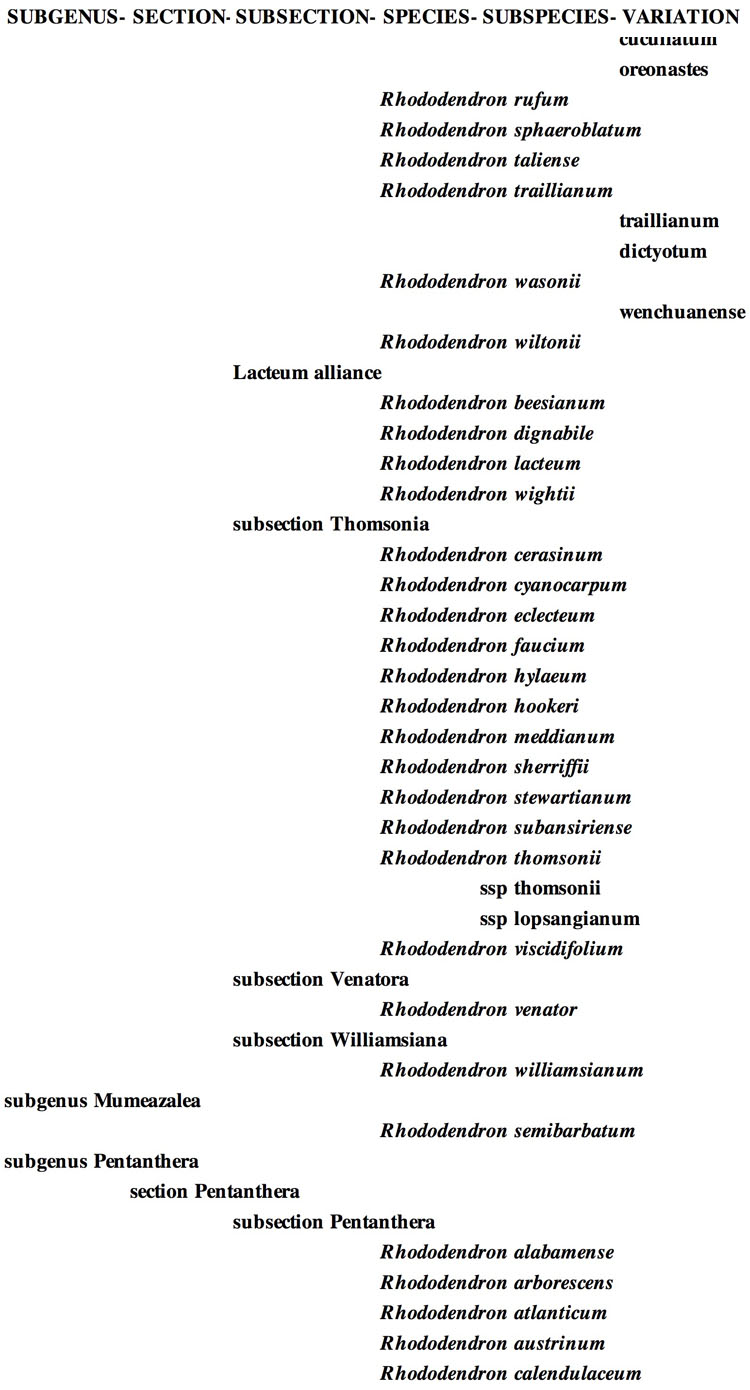 canescens, colemanii, cumberlandense, eastmanii, flammeum, luteum, occidentale, periclymenoides, prinophyllum, prunifolium, viscosum, subSinensia, molle, molle, japonicum, Rhodora, canadense, vaseyi, Sciadorhodion, albrechtii, pentaphyllum, quinquefolium, schlippenbachii, Viscidula, nipponicum, Rhododendron, Pogonanthum, anthopogon, anthopogon, hypenanthum, anthopogonoides, cephalanthum, cephalanthum, platyphllum, collettianum, fragrans, kongboense, laudandum, laudandum, temoense, primuliflorum, sargentianum, trichostomum, Rhododendron, subAfghanica
canescens, colemanii, cumberlandense, eastmanii, flammeum, luteum, occidentale, periclymenoides, prinophyllum, prunifolium, viscosum, subSinensia, molle, molle, japonicum, Rhodora, canadense, vaseyi, Sciadorhodion, albrechtii, pentaphyllum, quinquefolium, schlippenbachii, Viscidula, nipponicum, Rhododendron, Pogonanthum, anthopogon, anthopogon, hypenanthum, anthopogonoides, cephalanthum, cephalanthum, platyphllum, collettianum, fragrans, kongboense, laudandum, laudandum, temoense, primuliflorum, sargentianum, trichostomum, Rhododendron, subAfghanica
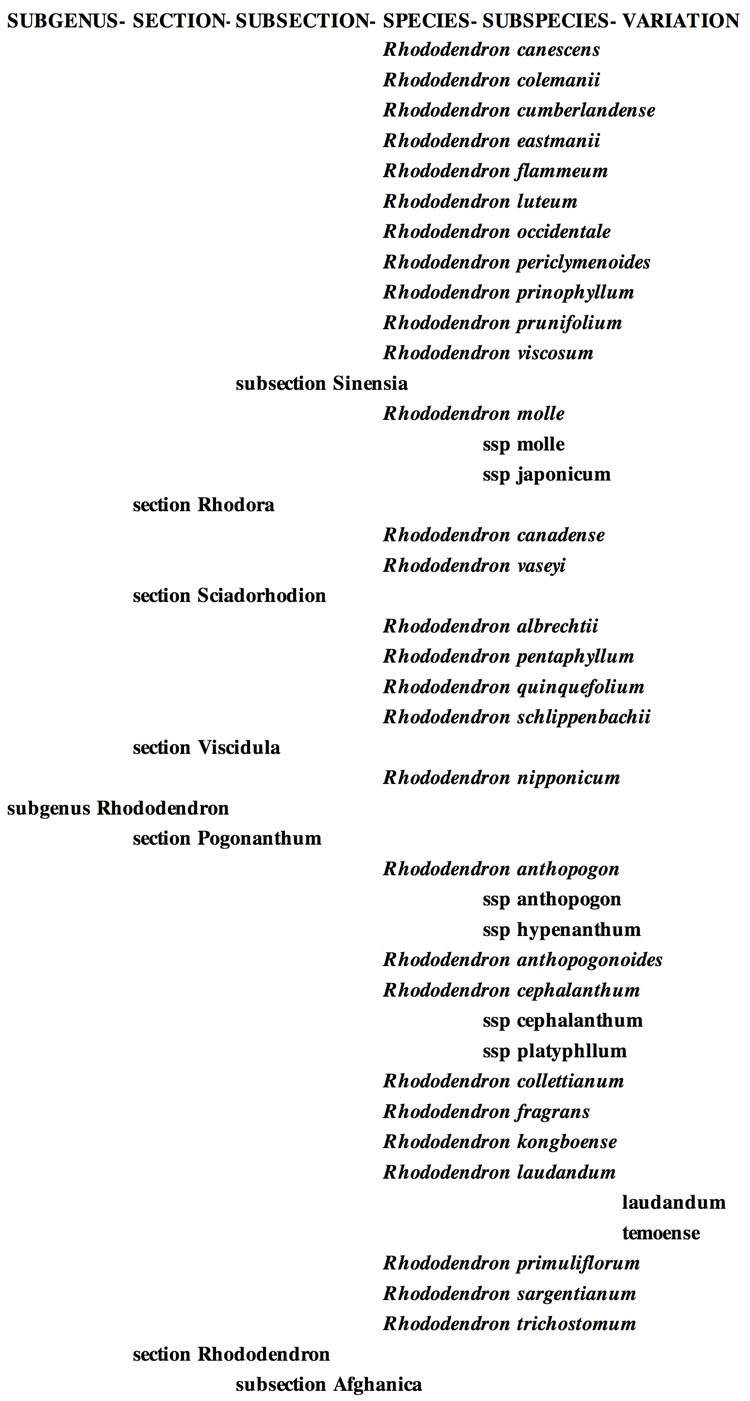 afghanicum, subBaileya, baileyi, subBoothia, boothii, chrysodoron, dekatanum, leptocarpum, leucaspis, megeratum, sulfureum, subCamelliiflora, camelliiflorum, subCampylogynum, campylogynum, subCaroliniana, minus, minus, champmanii, subCinnabarinum, cinnabarinum, cinnabarinum, tamaense, xanthocodon, keysii, subEdgeworthia, edgeworthii, pendulum, seinghkuense, subFragariflora, fragariiflorum, subGenestieriana, genestierianum, subGlauca, brachyanthum, brachyanthum, hypolepidotum, charitopes, charitopes, tsangpoense, glaucophyllum, glaucophyllum, album, tubiforme, luteiflorum
afghanicum, subBaileya, baileyi, subBoothia, boothii, chrysodoron, dekatanum, leptocarpum, leucaspis, megeratum, sulfureum, subCamelliiflora, camelliiflorum, subCampylogynum, campylogynum, subCaroliniana, minus, minus, champmanii, subCinnabarinum, cinnabarinum, cinnabarinum, tamaense, xanthocodon, keysii, subEdgeworthia, edgeworthii, pendulum, seinghkuense, subFragariflora, fragariiflorum, subGenestieriana, genestierianum, subGlauca, brachyanthum, brachyanthum, hypolepidotum, charitopes, charitopes, tsangpoense, glaucophyllum, glaucophyllum, album, tubiforme, luteiflorum
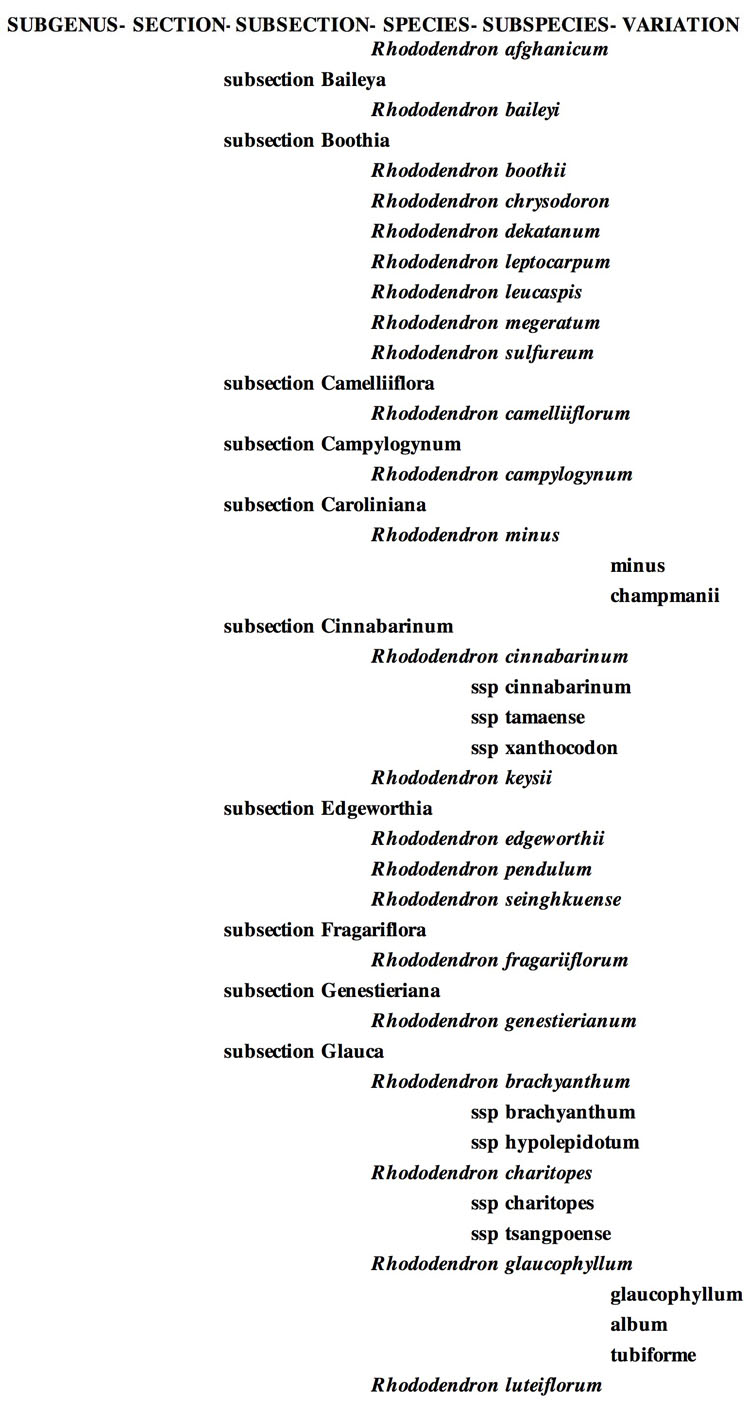 pruniflorum, shweliense, subHeliolepida, bracteatum, heliolepis, heliolepis, brevistylum, fumidum, rubiginosum, subLapponica, bulu, capitatum, complexum, cuneatum, dasypetalum, fastigiatum, flavidum, hippophaeoides, hippophaeoides, occidentale, impeditum, intricatum, lapponicum, nitidulum, nitidulum, omeiense, nivale, nivale, boreale, australe, orthocladum, orthocladum, microleucum, polycladum, rupicola, rupicola, chryseum, muliense, russatum, setosum, tapetiforme, telmateium, thymiflolium, tsaii, websterianum
pruniflorum, shweliense, subHeliolepida, bracteatum, heliolepis, heliolepis, brevistylum, fumidum, rubiginosum, subLapponica, bulu, capitatum, complexum, cuneatum, dasypetalum, fastigiatum, flavidum, hippophaeoides, hippophaeoides, occidentale, impeditum, intricatum, lapponicum, nitidulum, nitidulum, omeiense, nivale, nivale, boreale, australe, orthocladum, orthocladum, microleucum, polycladum, rupicola, rupicola, chryseum, muliense, russatum, setosum, tapetiforme, telmateium, thymiflolium, tsaii, websterianum
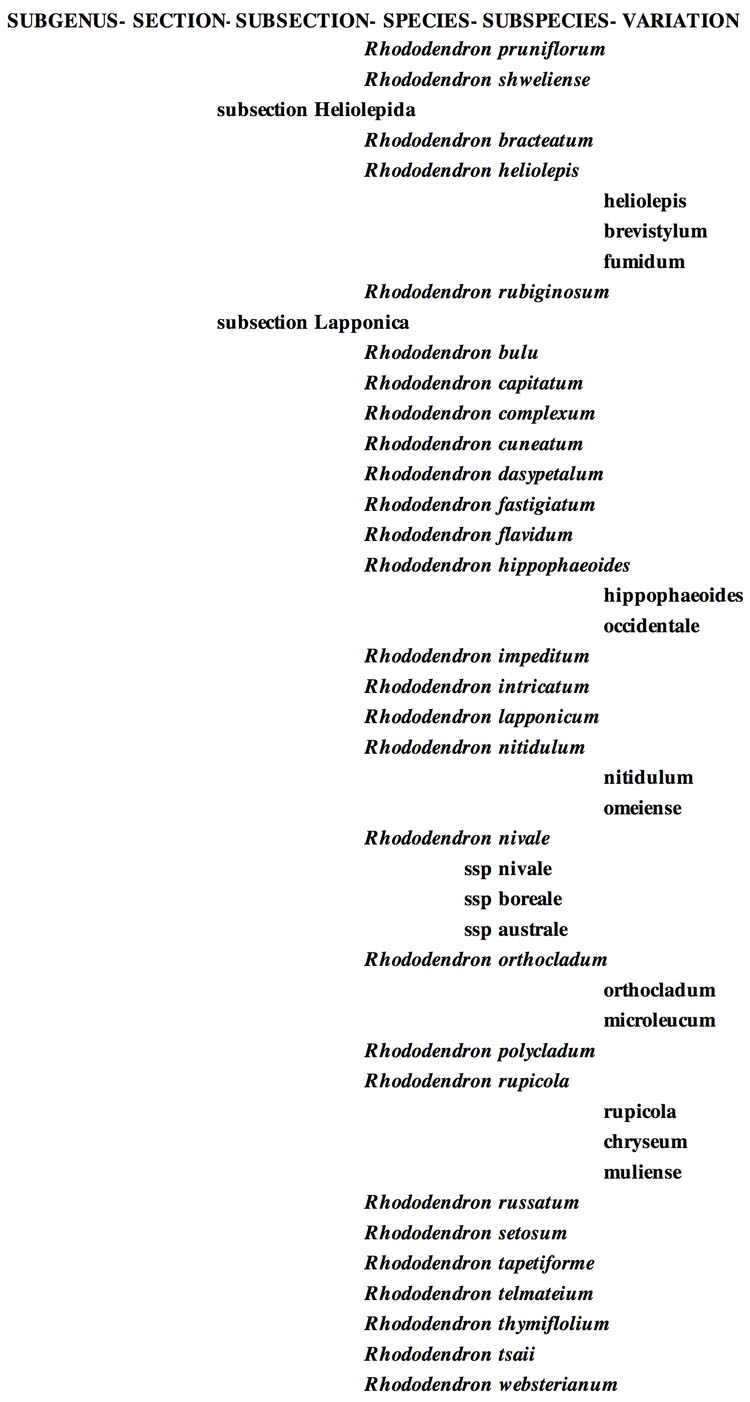 yungningense, subLedum, groenlandicum, hypoleucum, neoglandulosum, tolmachevii, tomentosum, subLepidota, cowanianum, lepidotum, lowndesii, subMaddenia, burmanicum, carneum, ciliatum, coxianum, dalhousiae, dalhousiae, rhabdotum, dendricola, excellens, fletcherianum, formosum, formosum, inaequale, horlickianum, johnstoneanum, leptocladon, levinei, liliiflorum, lindleyi, ludwigianum, lyi, maddenii, maddenii, crassum, megacalyx, nuttallii, pachypodum, pseudociliipes, roseatum, scopulorum, taggianum, valentinianum, veitchianum
yungningense, subLedum, groenlandicum, hypoleucum, neoglandulosum, tolmachevii, tomentosum, subLepidota, cowanianum, lepidotum, lowndesii, subMaddenia, burmanicum, carneum, ciliatum, coxianum, dalhousiae, dalhousiae, rhabdotum, dendricola, excellens, fletcherianum, formosum, formosum, inaequale, horlickianum, johnstoneanum, leptocladon, levinei, liliiflorum, lindleyi, ludwigianum, lyi, maddenii, maddenii, crassum, megacalyx, nuttallii, pachypodum, pseudociliipes, roseatum, scopulorum, taggianum, valentinianum, veitchianum
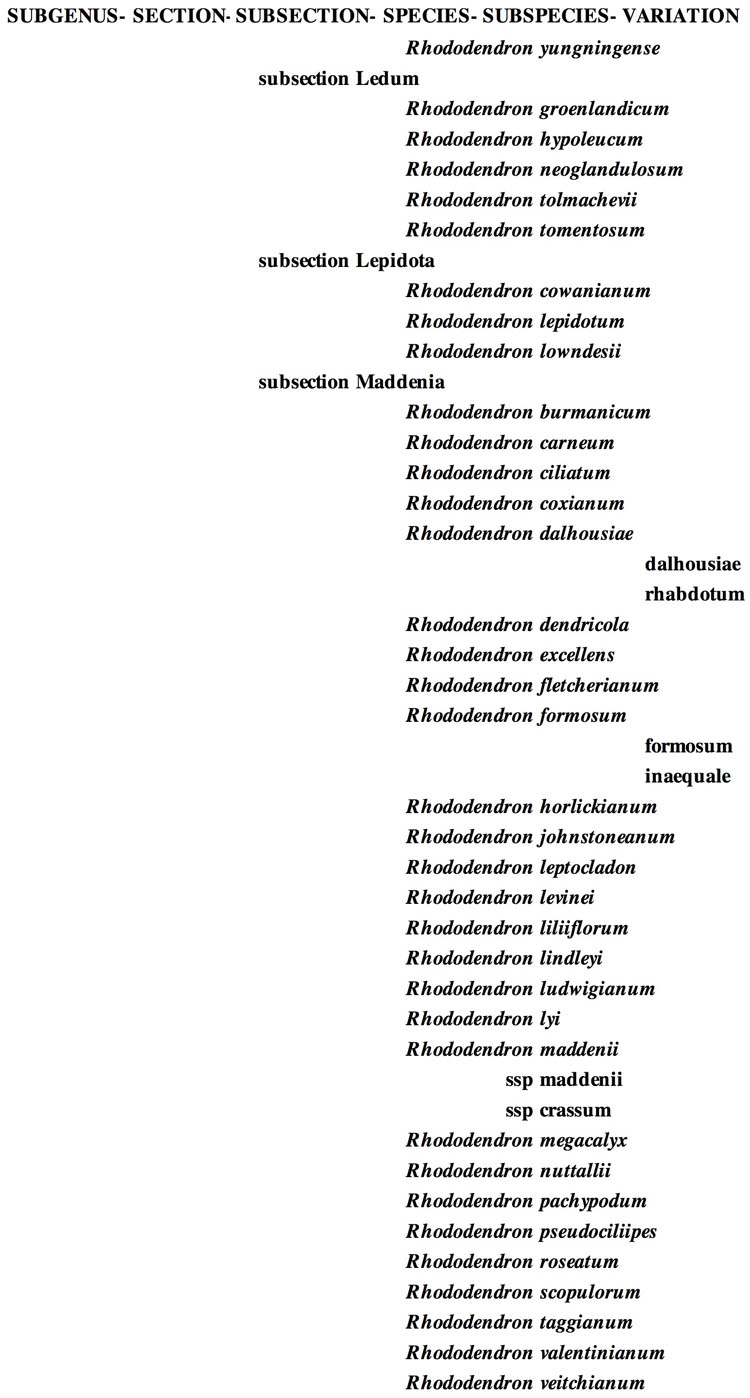 walongense, subMicrantha, micranthum, subMonantha, monanthum, subMoupinensia, dendrocharis, moupinense, petrocharis, subRhododendron, ferrugineum, hirsutum, myrtifolium, subRhodorastra, dauricum, mucronulatum, mucronulatum, taquetii, sichotense, subSaluenensia, calostrotum, calostrotum, riparium, riparioides, keleticum, saluenense, saluenense, chameunum, subScabrifolia, hemitrichotum, mollicomum, pubescens, racemosum, scabrifolium, scabrifolium, spiciferum, pauciflorum, spinuliferum, subTephropepia, auritum, hanceanum, longistylum, tephropeplum, xanthostephanum, subTrichoclada
walongense, subMicrantha, micranthum, subMonantha, monanthum, subMoupinensia, dendrocharis, moupinense, petrocharis, subRhododendron, ferrugineum, hirsutum, myrtifolium, subRhodorastra, dauricum, mucronulatum, mucronulatum, taquetii, sichotense, subSaluenensia, calostrotum, calostrotum, riparium, riparioides, keleticum, saluenense, saluenense, chameunum, subScabrifolia, hemitrichotum, mollicomum, pubescens, racemosum, scabrifolium, scabrifolium, spiciferum, pauciflorum, spinuliferum, subTephropepia, auritum, hanceanum, longistylum, tephropeplum, xanthostephanum, subTrichoclada
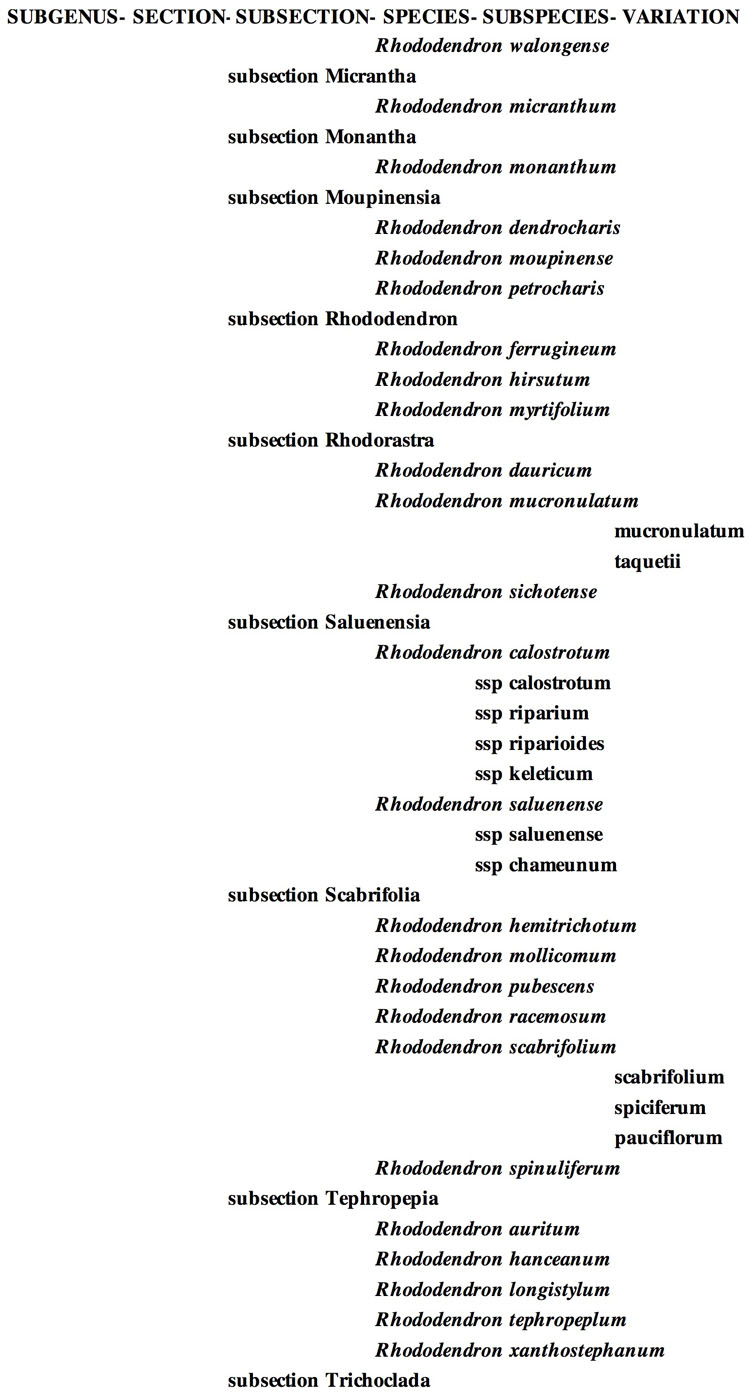 caesium, lepidostylum, mekongense, mekongense, rubrolineatum, trichocladum, viridescens, subTriflora, Augustinii/Triflorum Alliance, ambiguum, augustinii, augustinii, chasmanthum, hardyi, rubrum, concinnum, keiskei, keiski, ozawae, lutescens, polylepis, seariane, trichanthum, triflorum, triflorum, zaleucum, zaleucum, flaviflorum, Yunnanense Alliance, davidsonianum, rigidum, siderophyllum, tatsienense, yunnanense, Oreotrephes Alliance, oreotrephes, subUniflora, imperator, ludlowii, pemakoense, pumilum, uniflorum, subVirgata, virgatum, virgatum
caesium, lepidostylum, mekongense, mekongense, rubrolineatum, trichocladum, viridescens, subTriflora, Augustinii/Triflorum Alliance, ambiguum, augustinii, augustinii, chasmanthum, hardyi, rubrum, concinnum, keiskei, keiski, ozawae, lutescens, polylepis, seariane, trichanthum, triflorum, triflorum, zaleucum, zaleucum, flaviflorum, Yunnanense Alliance, davidsonianum, rigidum, siderophyllum, tatsienense, yunnanense, Oreotrephes Alliance, oreotrephes, subUniflora, imperator, ludlowii, pemakoense, pumilum, uniflorum, subVirgata, virgatum, virgatum
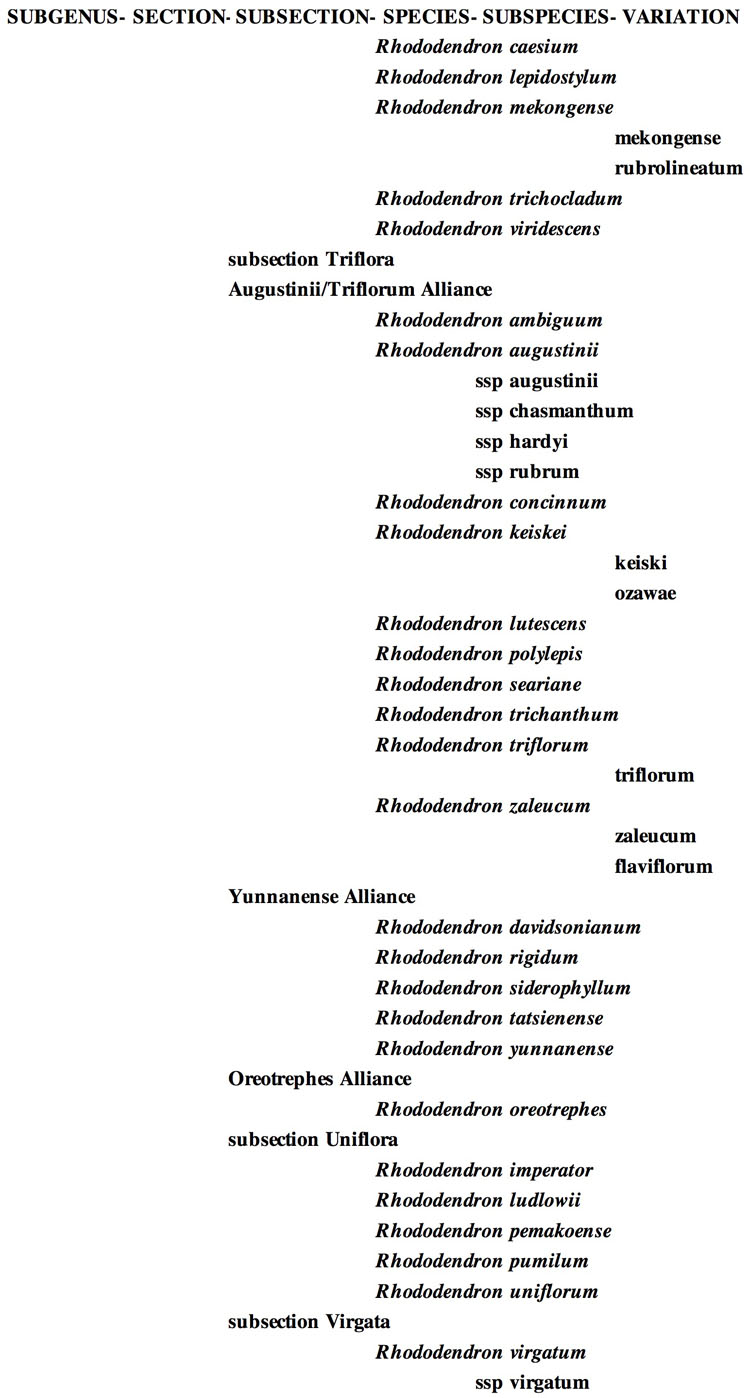 oleifolium, Vireya, subPseudovireya, euonymifolium, kawakamii, rushforthii, santapauii, vacciniodes, Therorhodion, camtschaticum, camtschaticum, glandulosum, redowskianun, Tsutsusi, Brachycalyx, Farrerae Alliance, farrerae, mariesii, Reticulatum Alliance, reticulatum, decandrum, dilatatum, hidakanum, kiyosumense, mayebarae, nudipes, nupides, niphophilum, viscistylum, wadanum, Weyrichii Alliance, amagianum, sanctum, weyrichii, Tsutsusi, atrovirens, breviperulatum, eriocarpum, indicum, kaempferi, kanehirai, kiusianum, kiusianum, sataense, microphyton
oleifolium, Vireya, subPseudovireya, euonymifolium, kawakamii, rushforthii, santapauii, vacciniodes, Therorhodion, camtschaticum, camtschaticum, glandulosum, redowskianun, Tsutsusi, Brachycalyx, Farrerae Alliance, farrerae, mariesii, Reticulatum Alliance, reticulatum, decandrum, dilatatum, hidakanum, kiyosumense, mayebarae, nudipes, nupides, niphophilum, viscistylum, wadanum, Weyrichii Alliance, amagianum, sanctum, weyrichii, Tsutsusi, atrovirens, breviperulatum, eriocarpum, indicum, kaempferi, kanehirai, kiusianum, kiusianum, sataense, microphyton
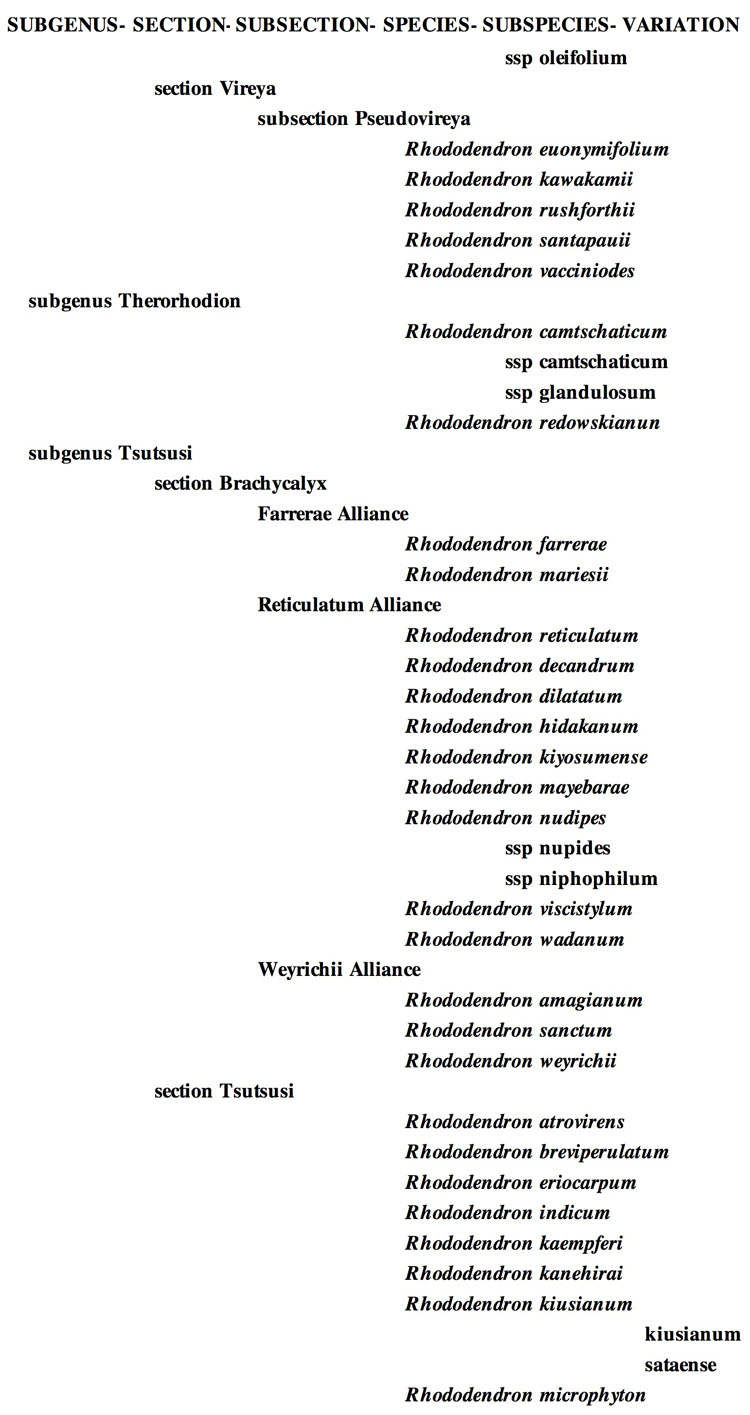 mucronatum, mucronatum, nakaharae, noriakianum, oldhamii, ripense, rubropilosum, saxicolum, scabrum, serpyllifolium, simsii, stenopetalum, subsessile, tashiroi, tosaense, tschonskii, tsuiophyllum, yedoense, poukhanense
mucronatum, mucronatum, nakaharae, noriakianum, oldhamii, ripense, rubropilosum, saxicolum, scabrum, serpyllifolium, simsii, stenopetalum, subsessile, tashiroi, tosaense, tschonskii, tsuiophyllum, yedoense, poukhanense
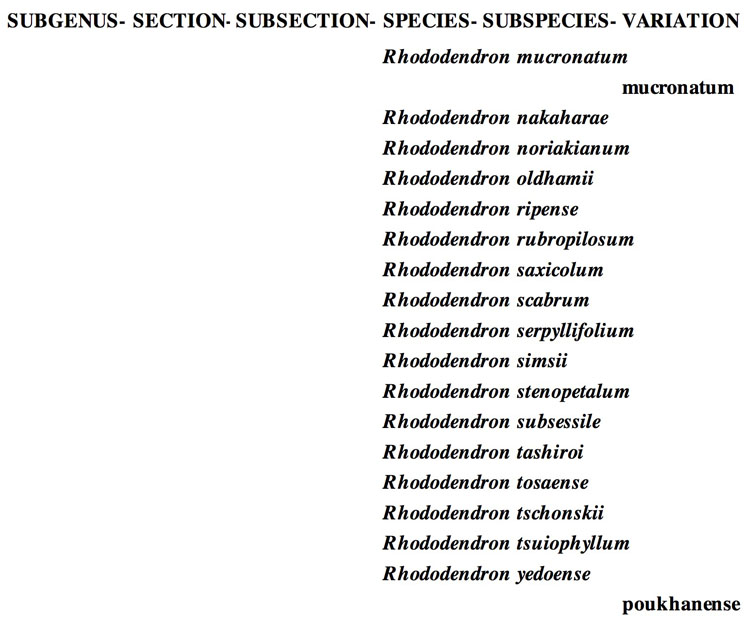
Return to Top
Directory of Contents for Henning's Rhododendron & Azalea Pages
•• Providing Information about the Genus Rhododendron since 1996
••
Articles Published by the American Rhododendron Society
Return to Top

Last Updated:
July 6, 2020
|